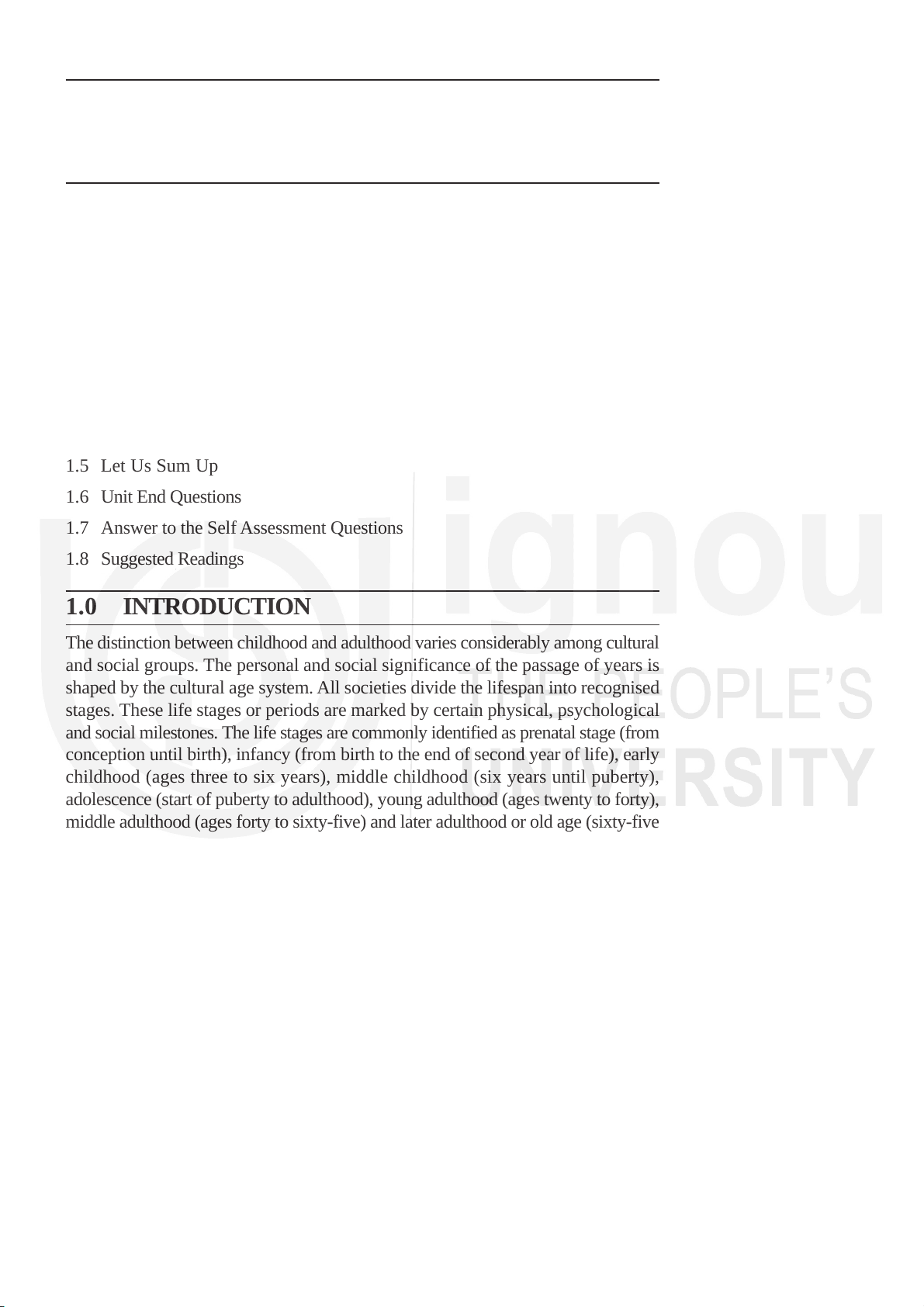
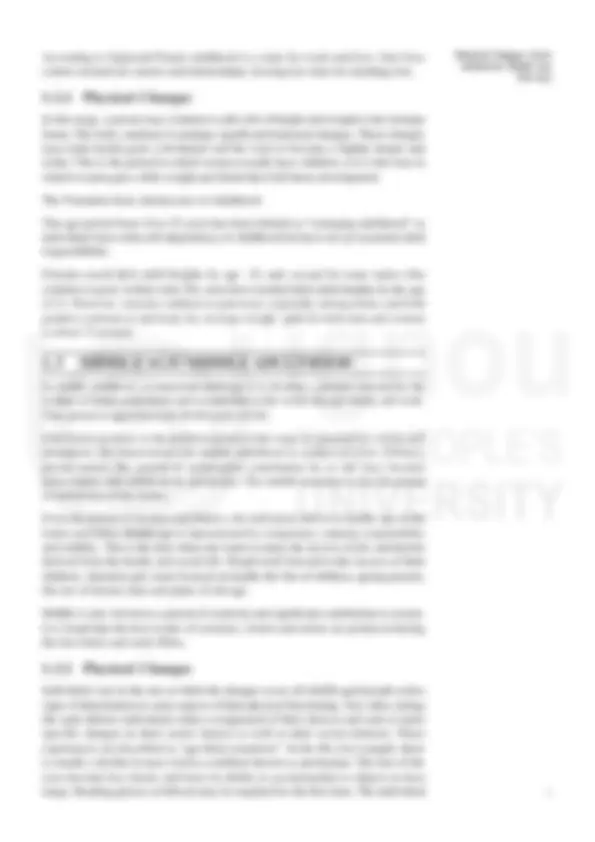
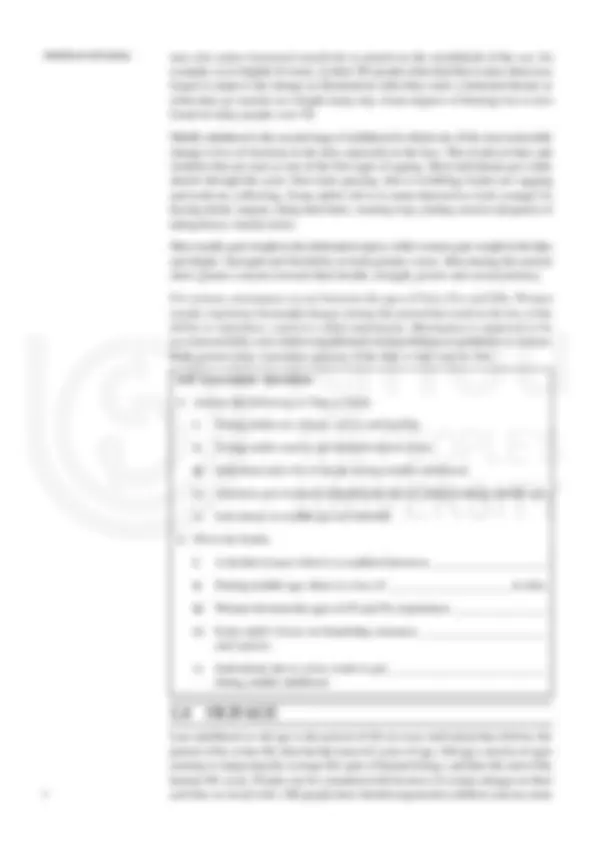
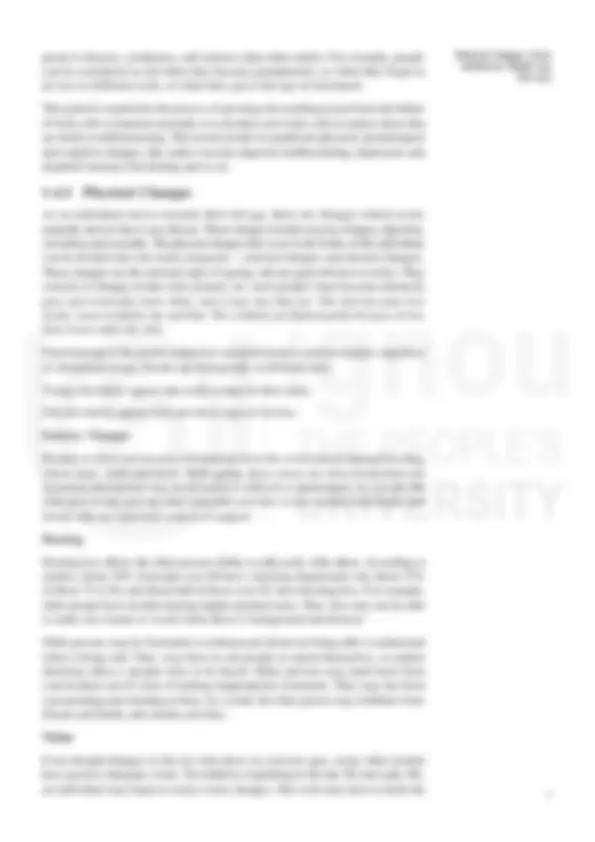
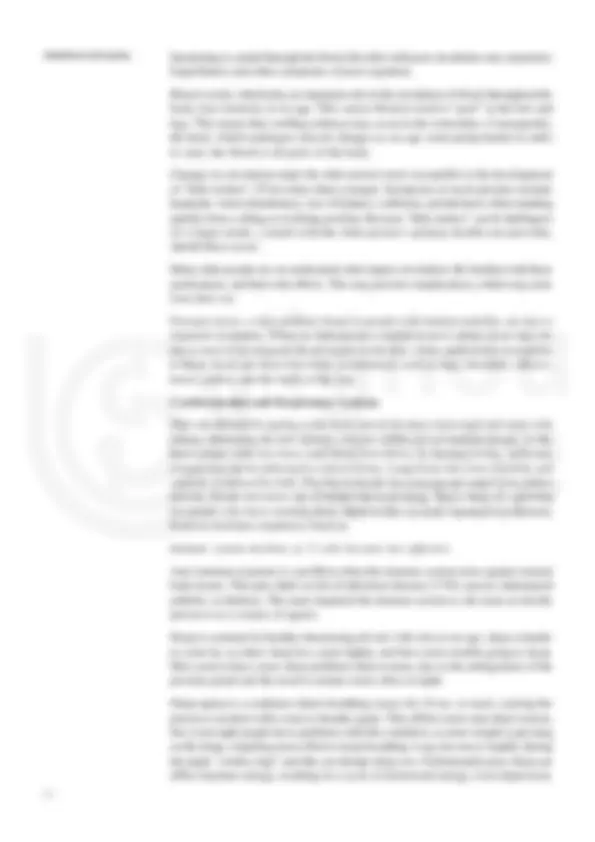
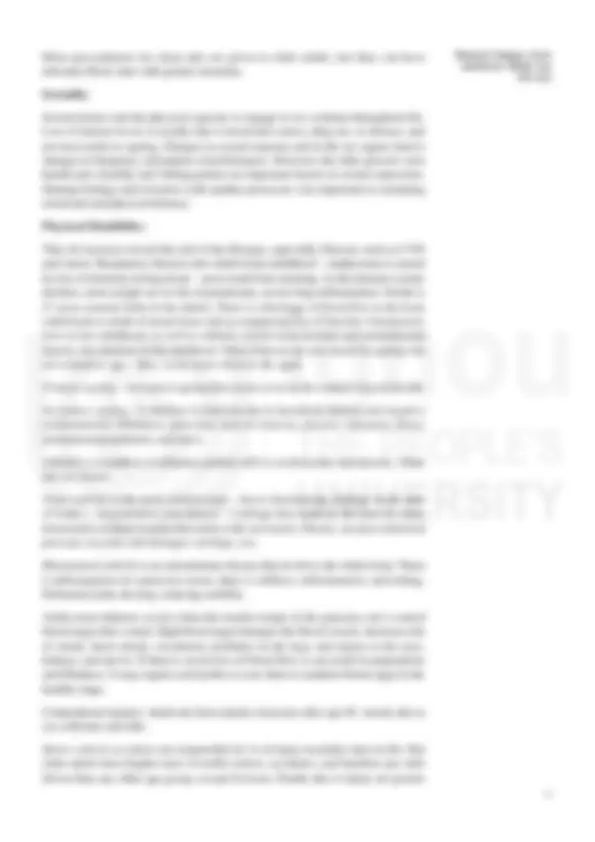
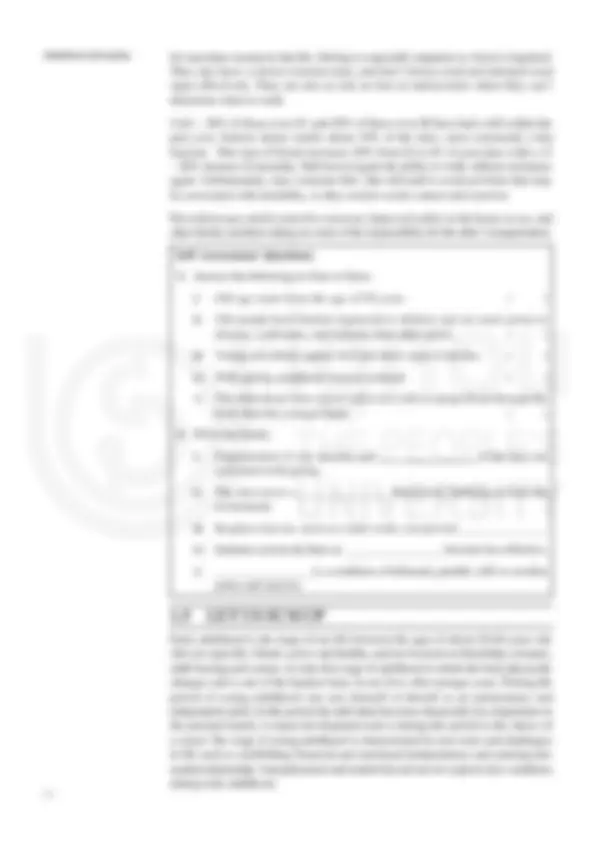
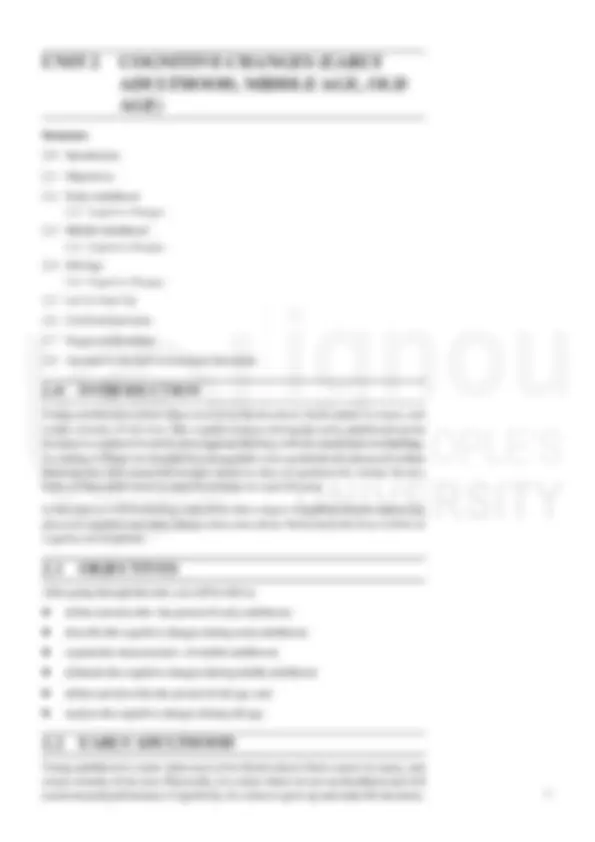
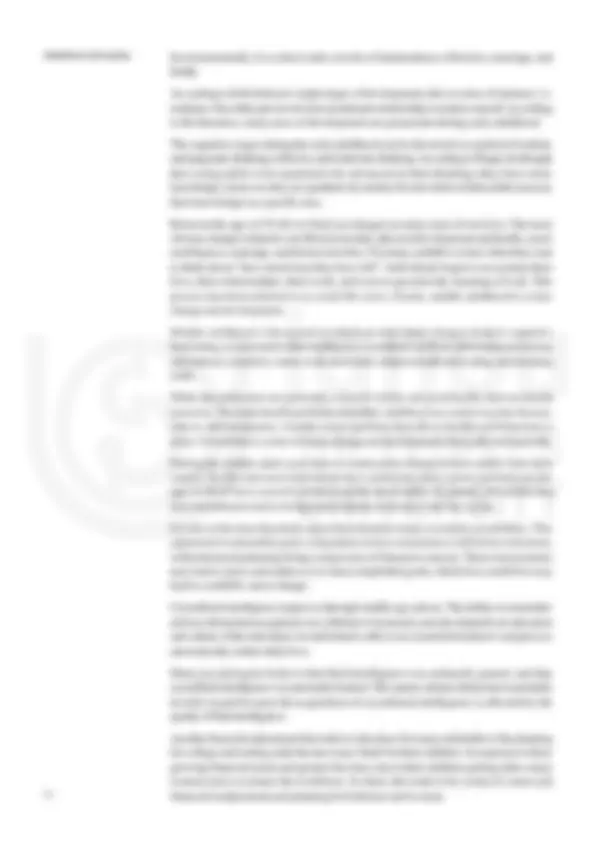
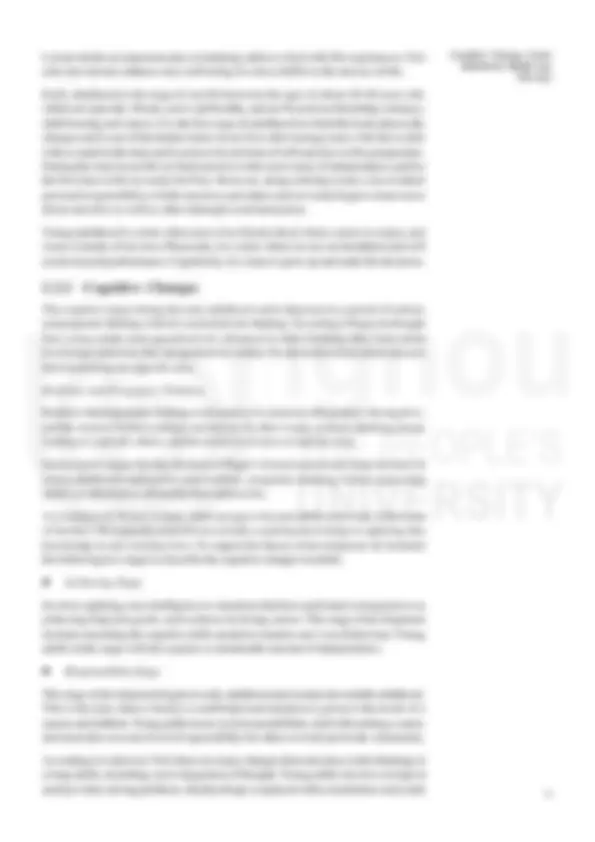
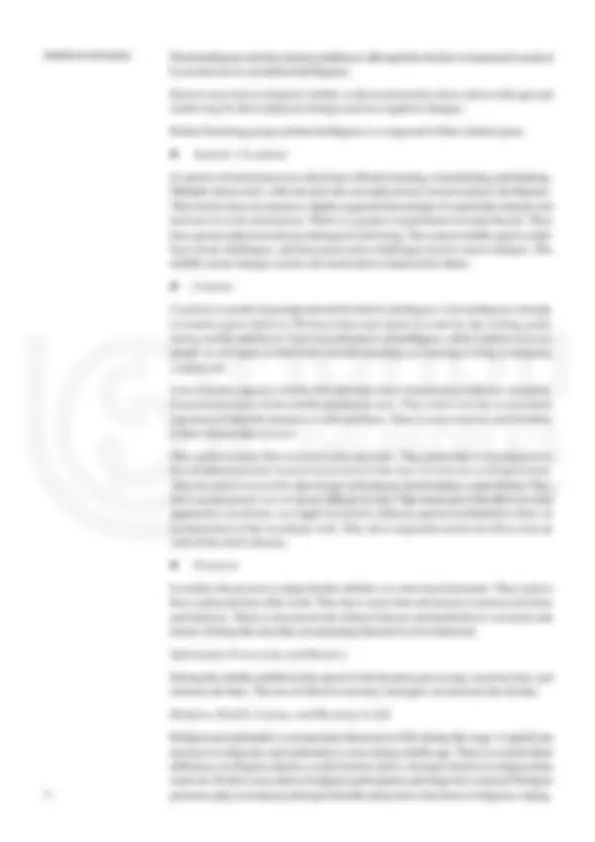
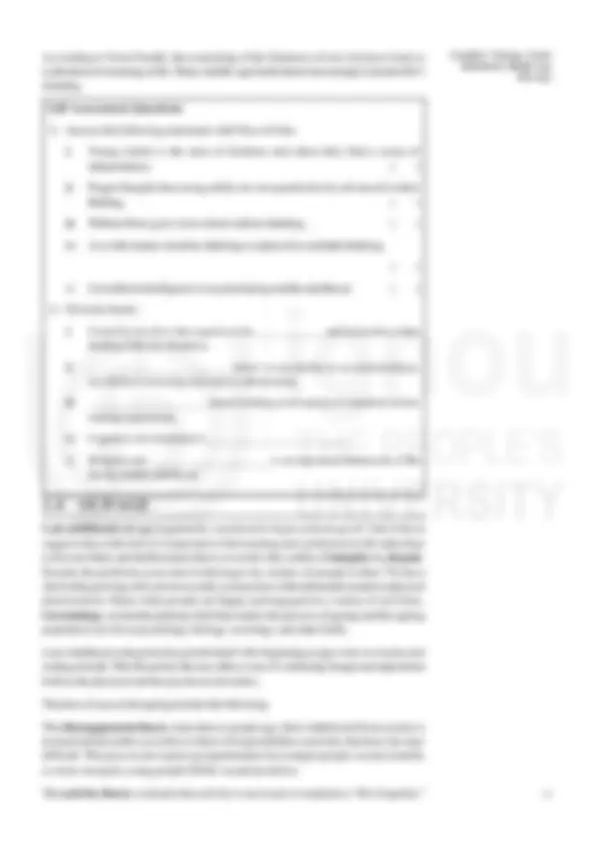
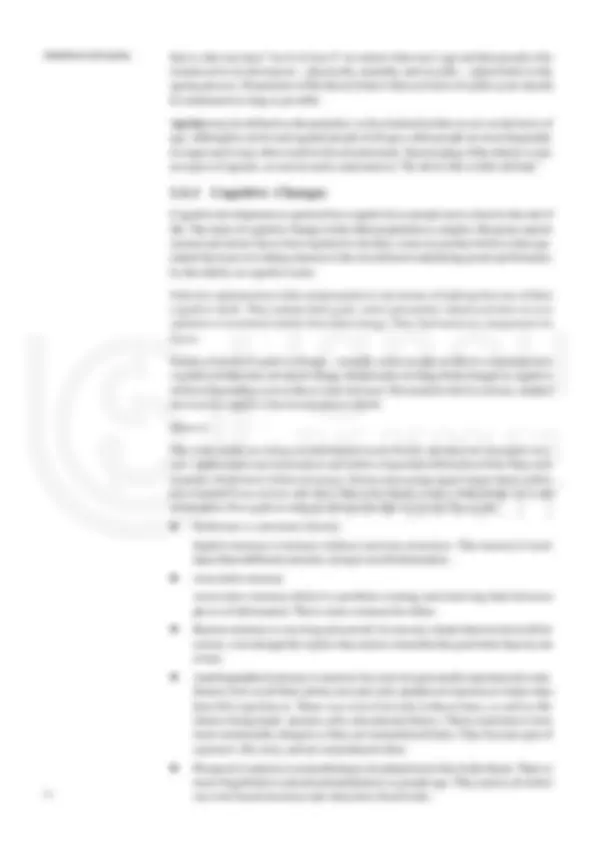
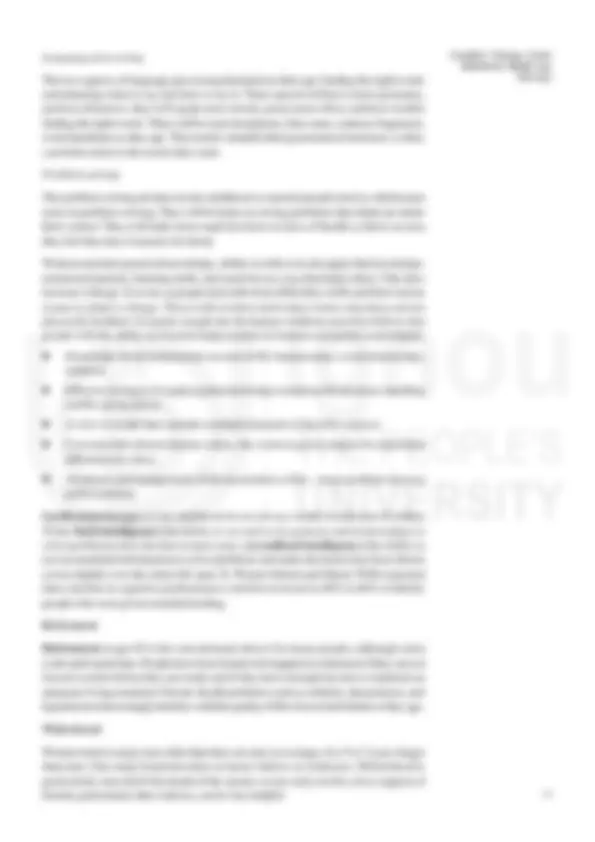
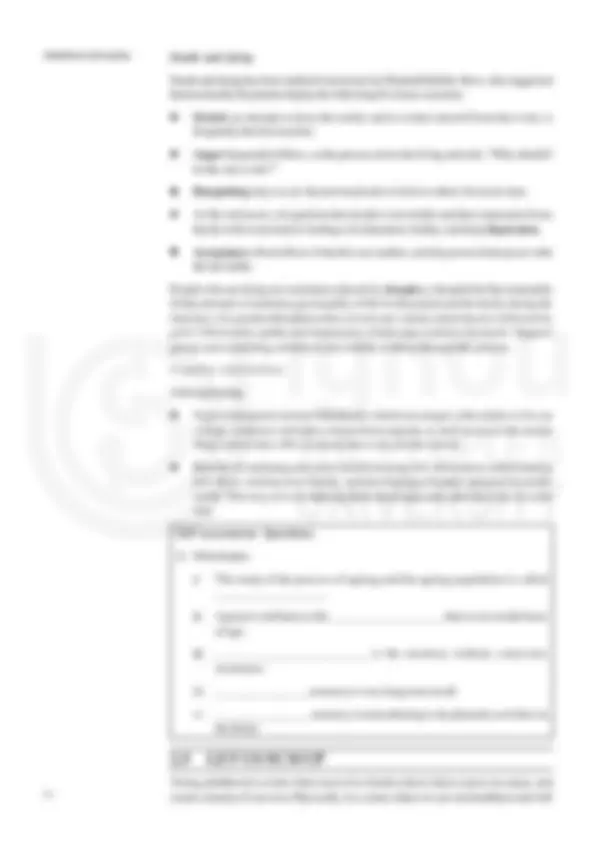
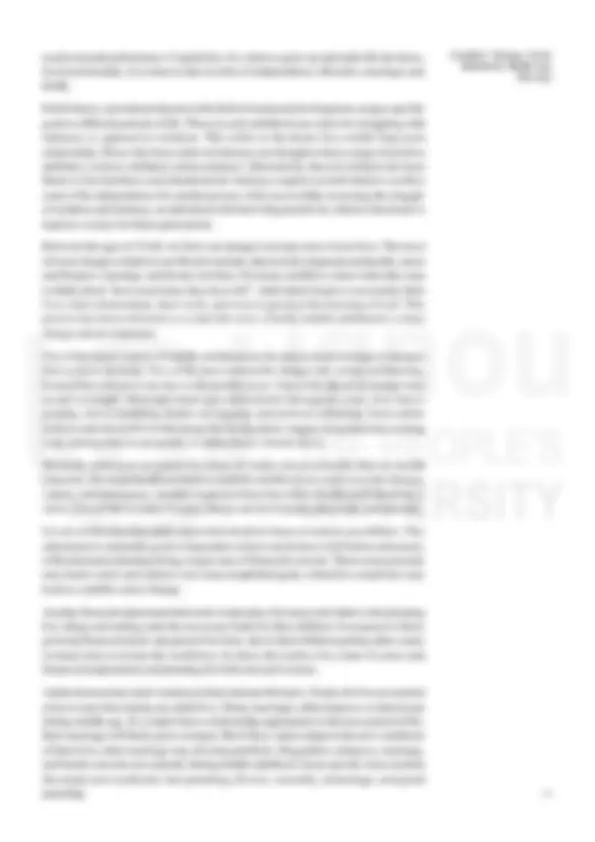
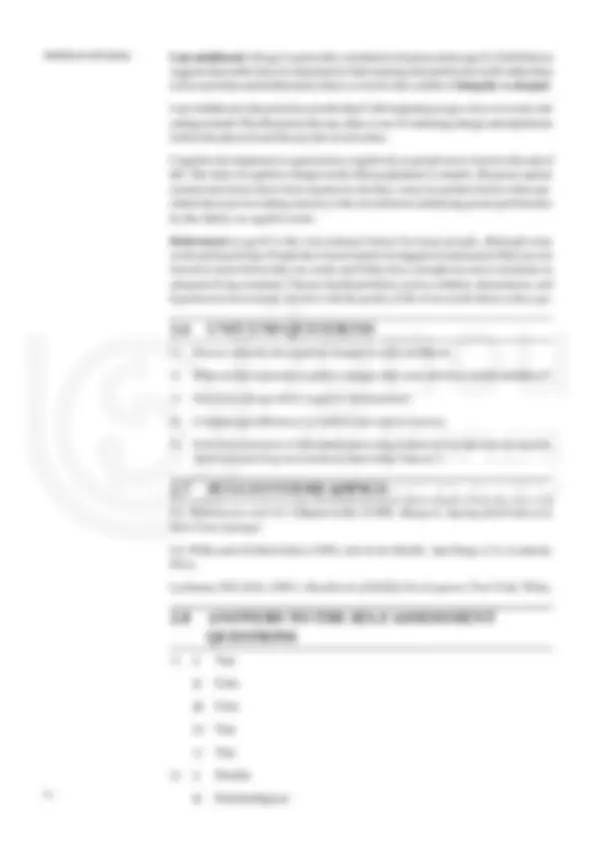
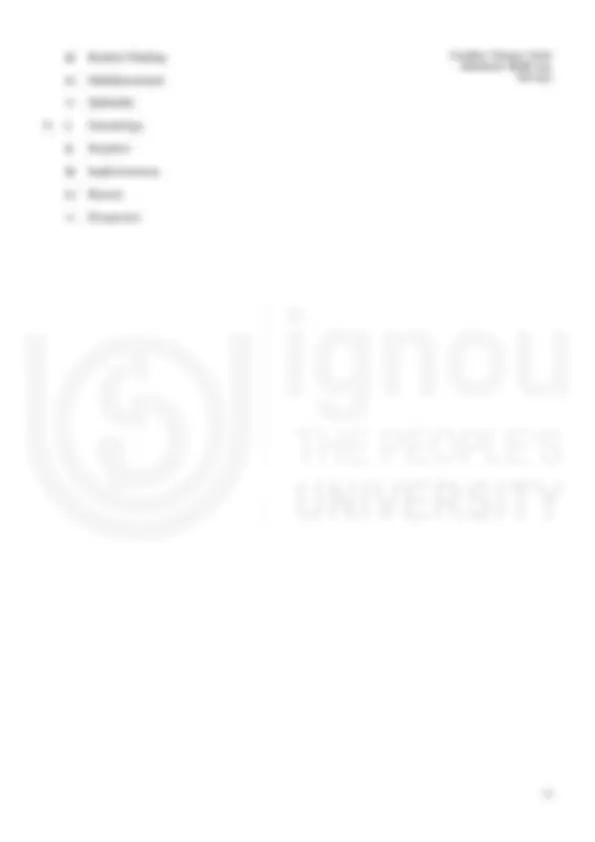
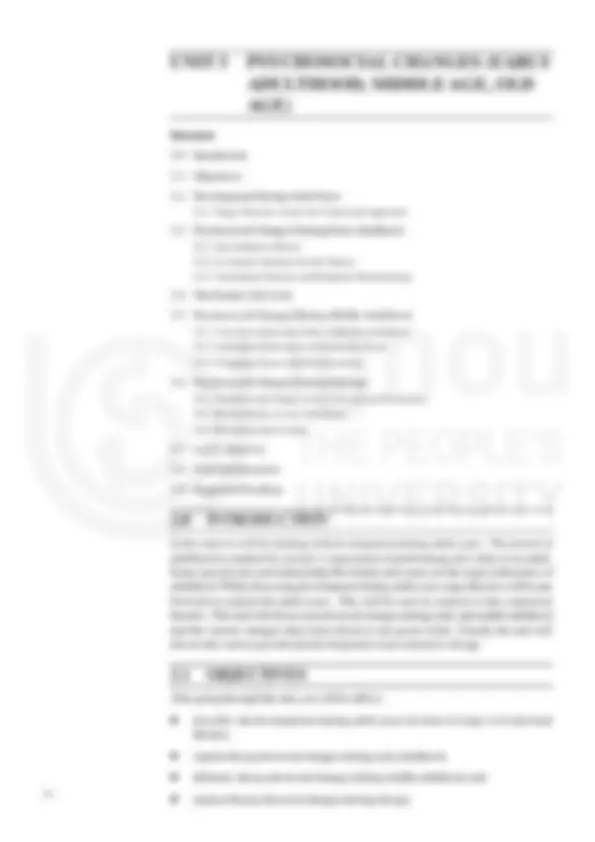
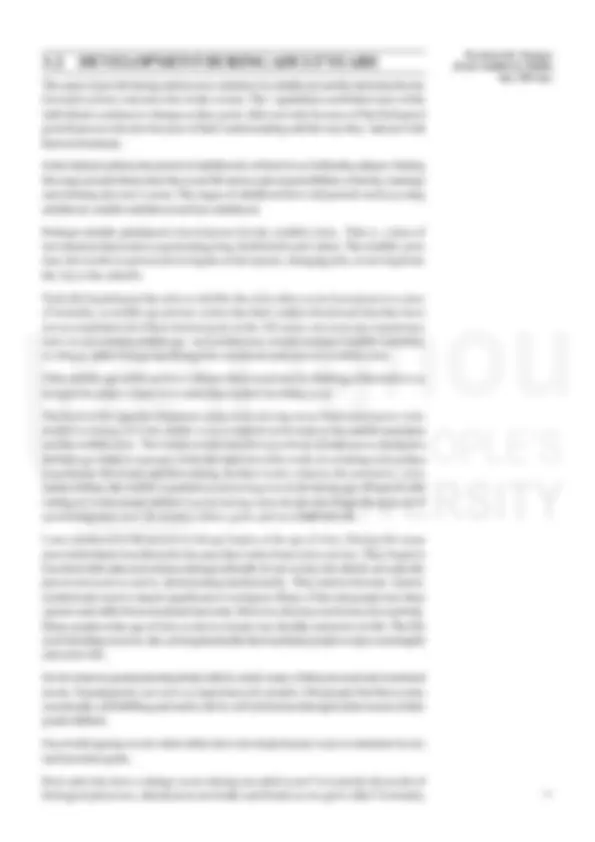
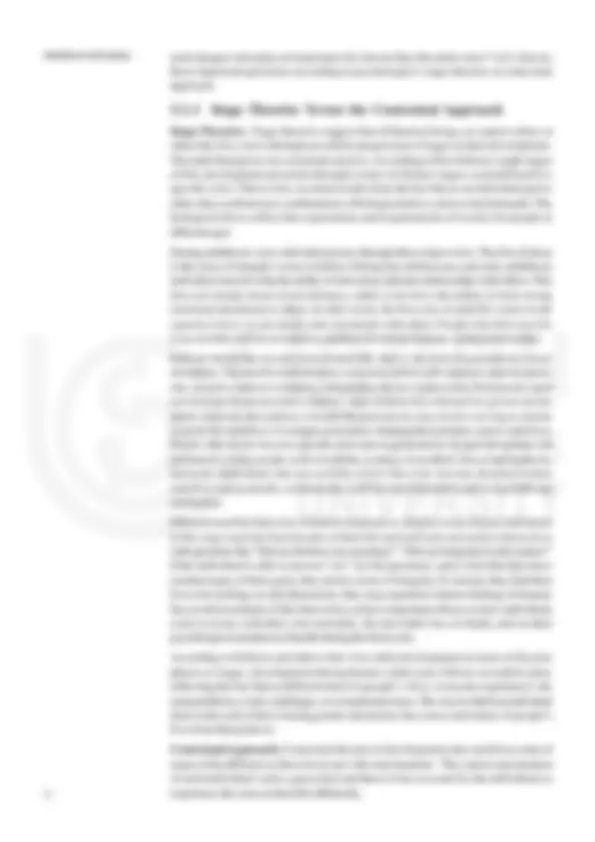
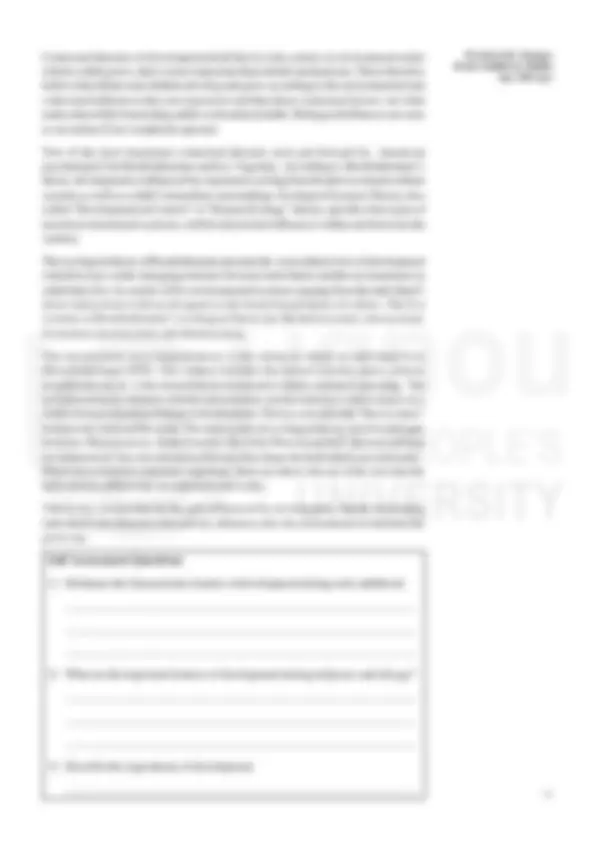
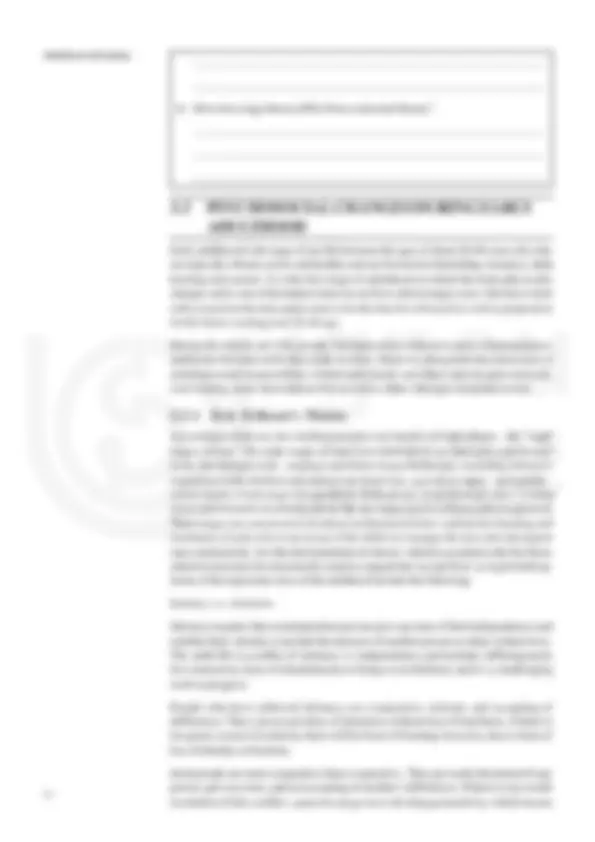
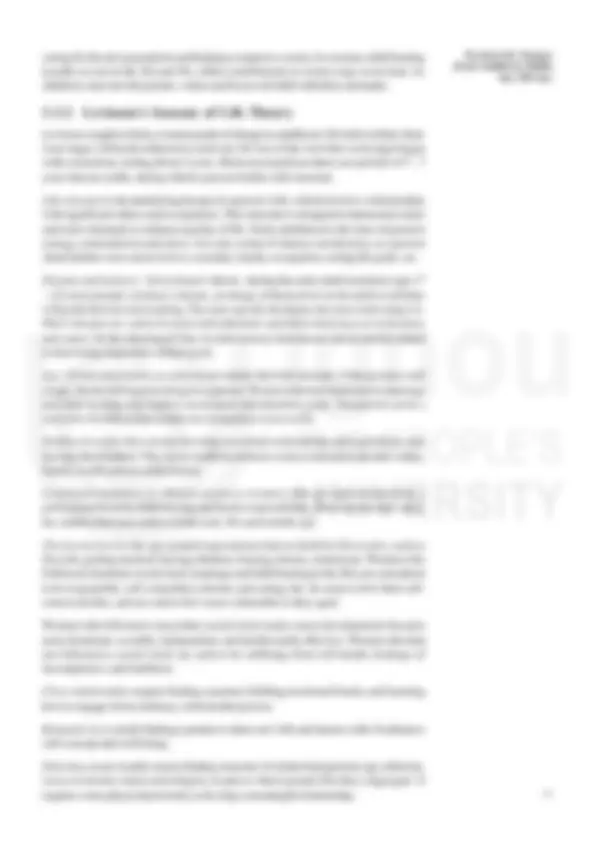
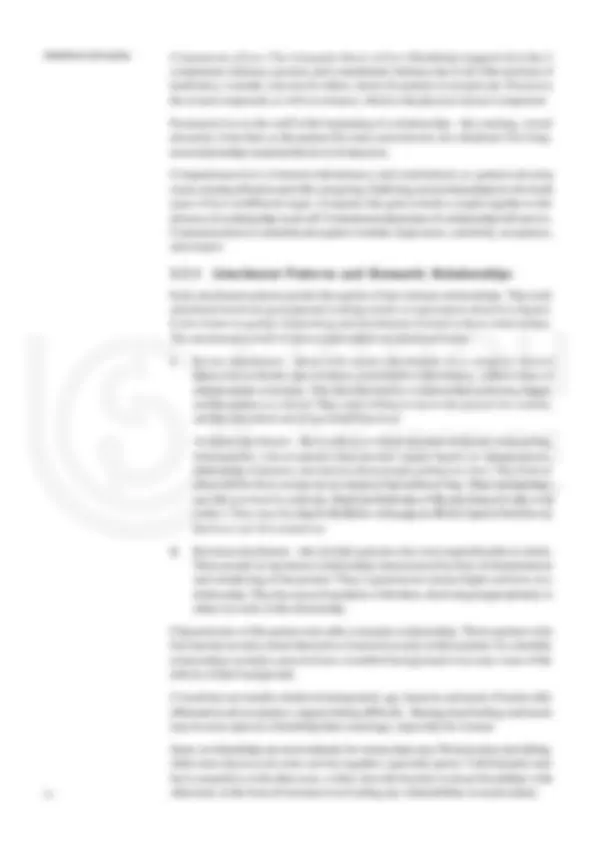
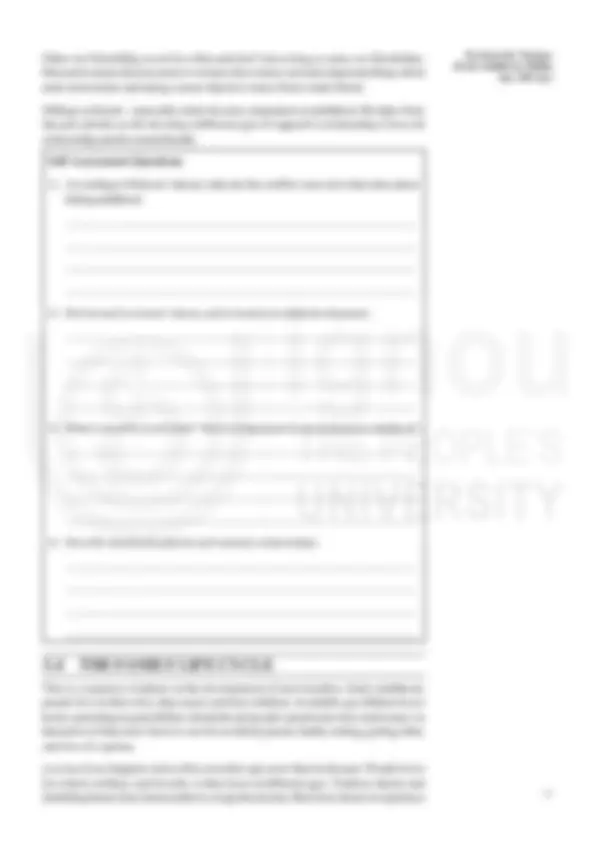

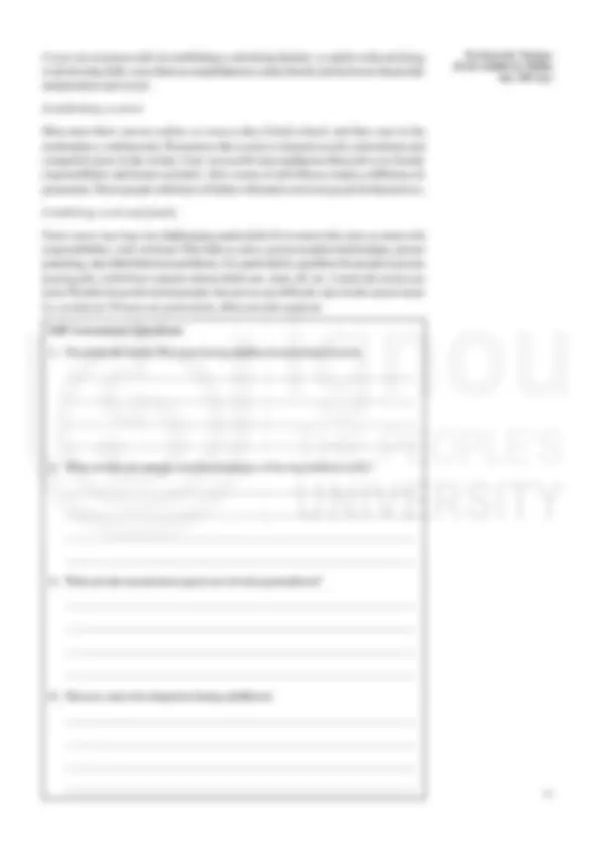
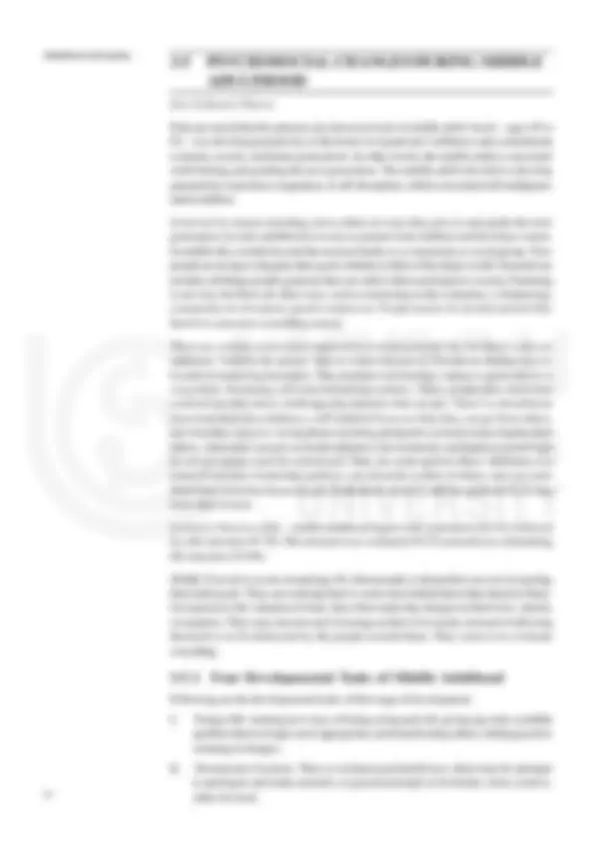
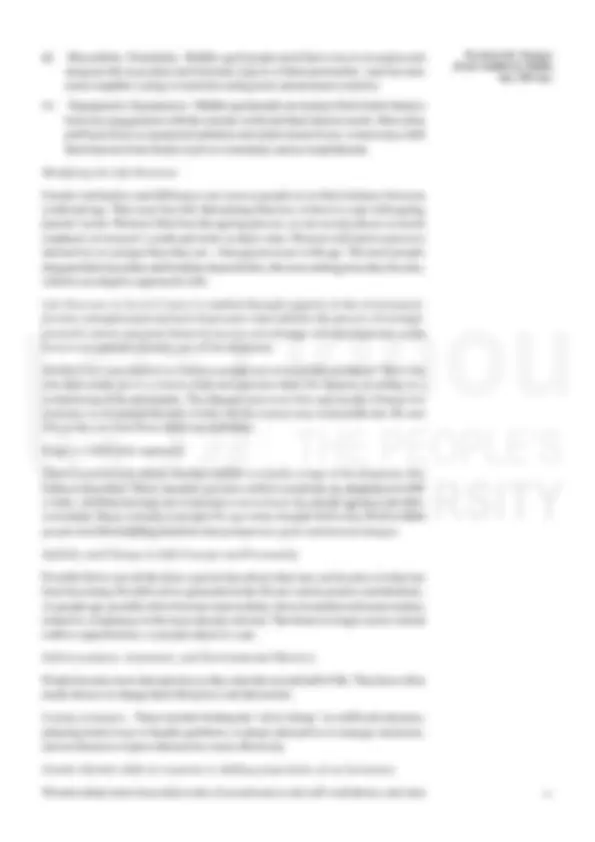
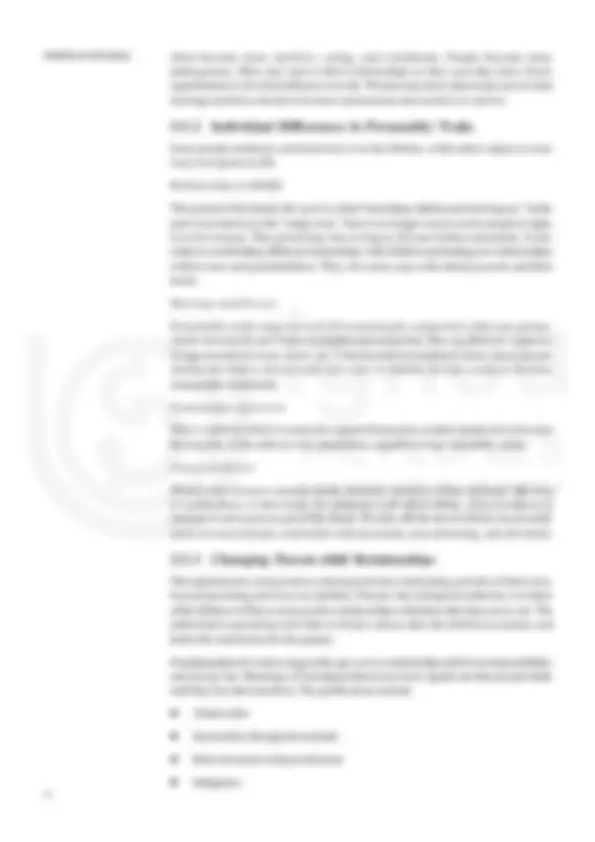
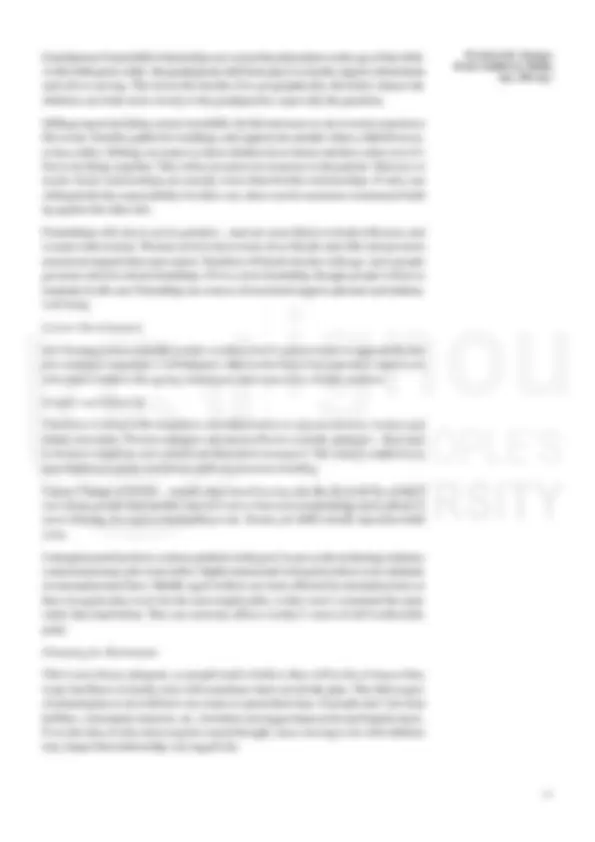
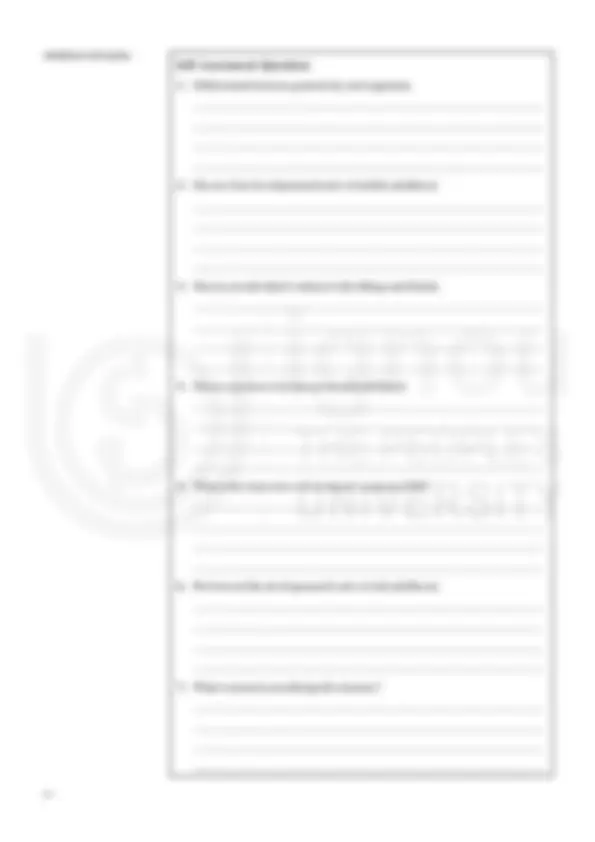
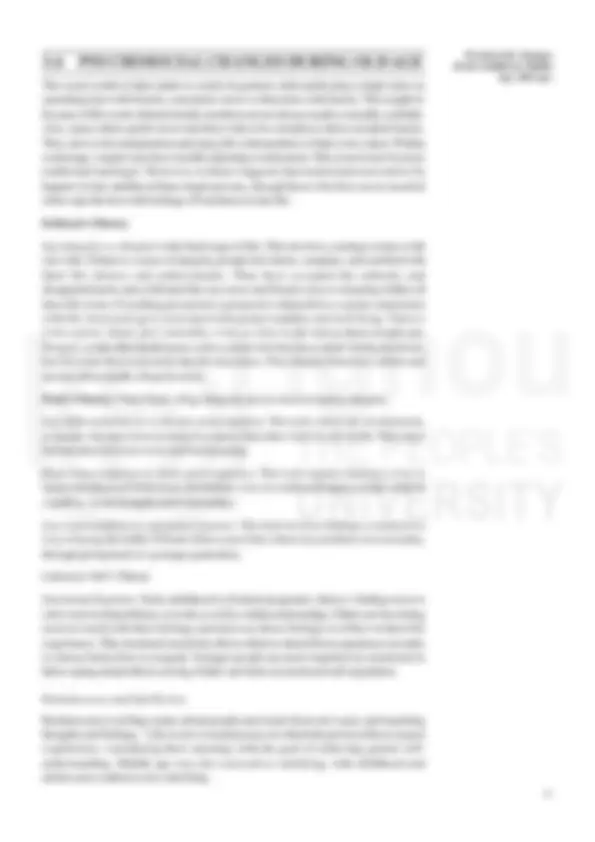
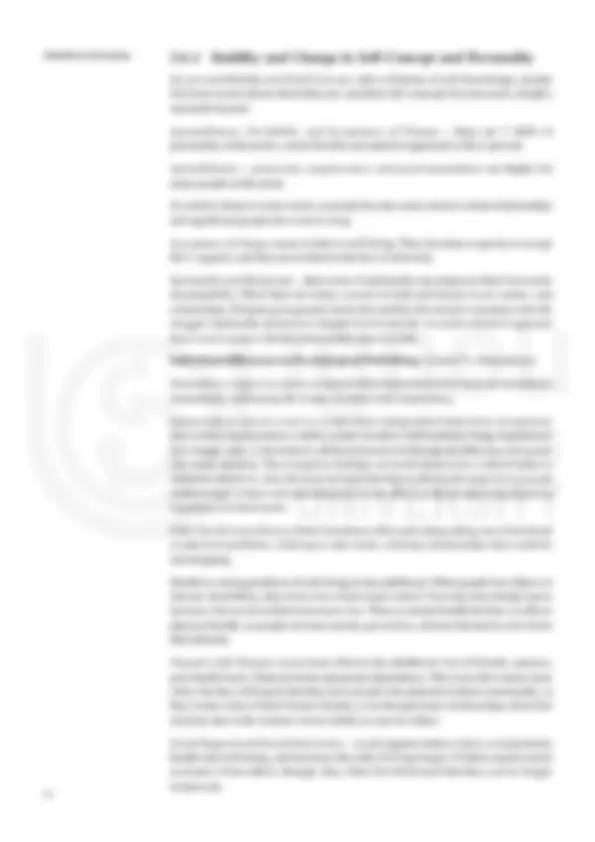
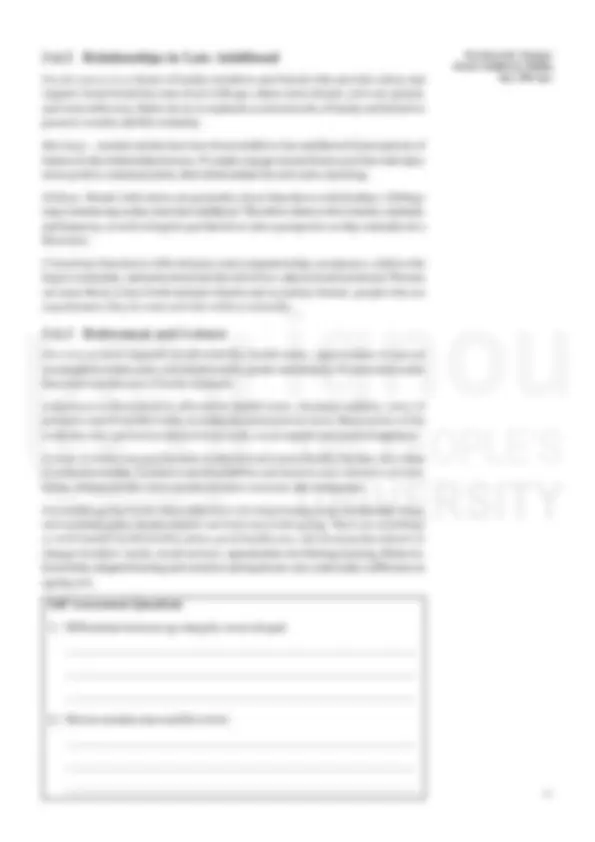
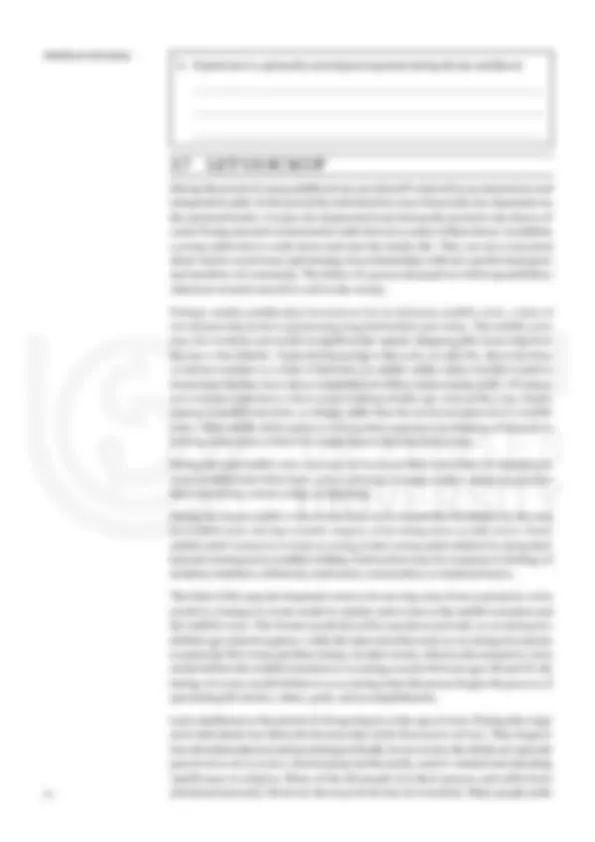
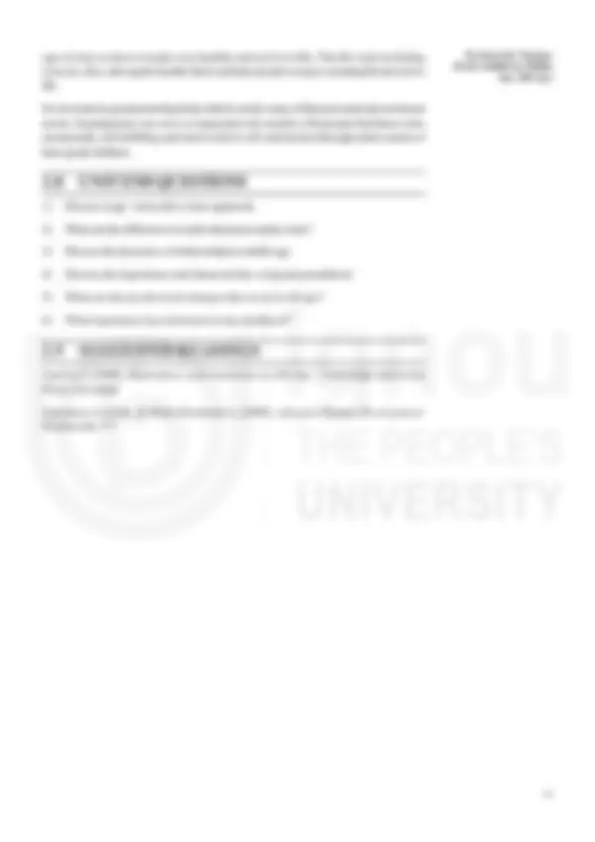
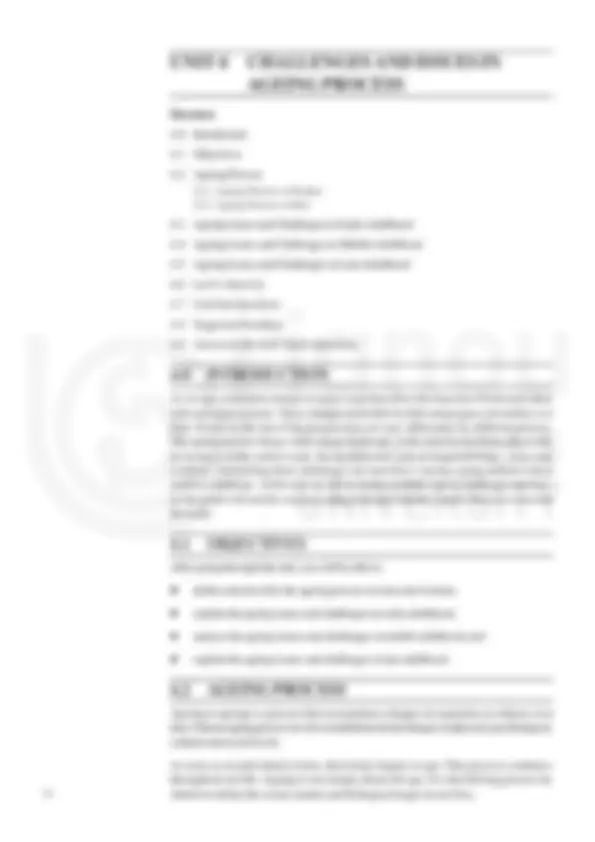
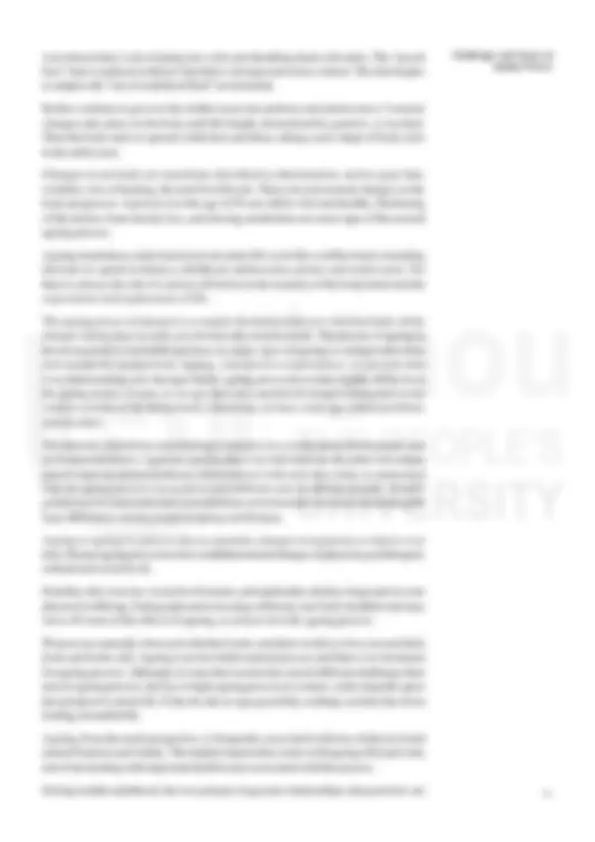
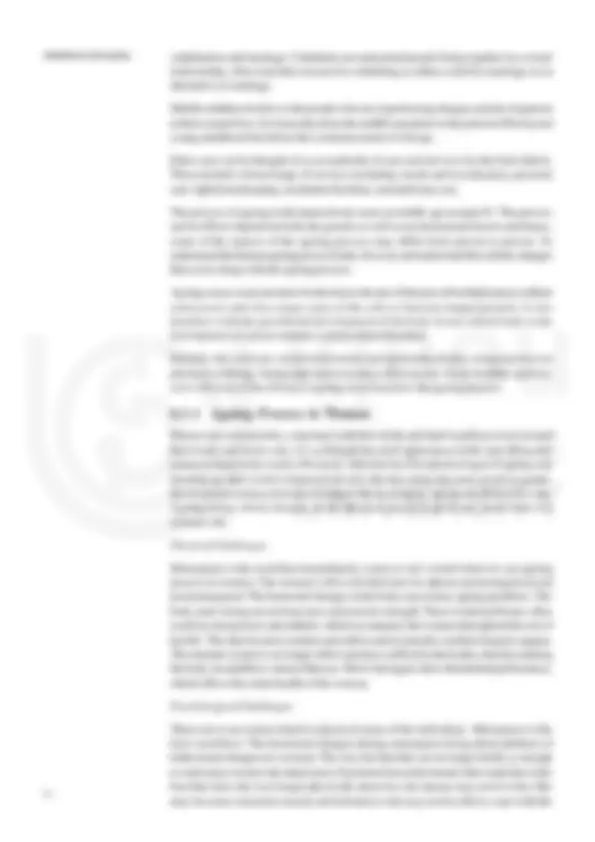
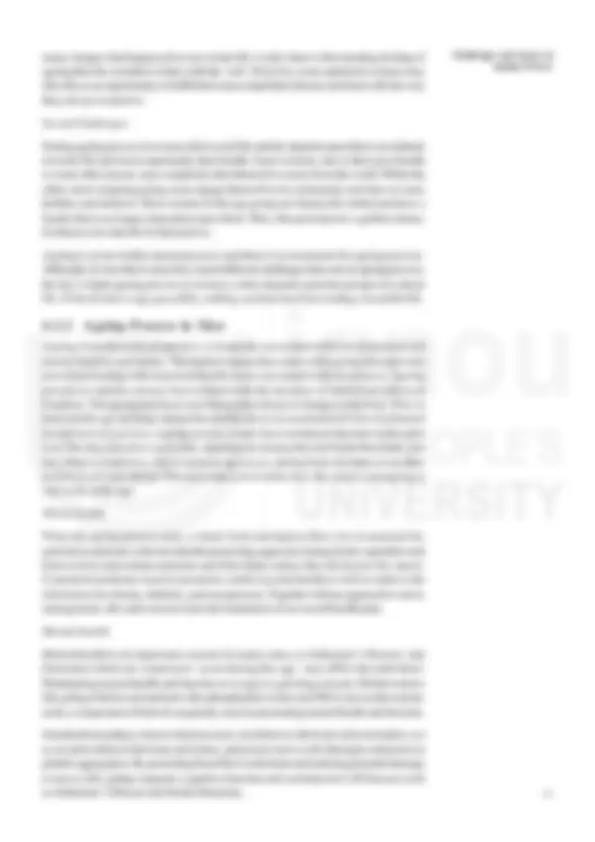
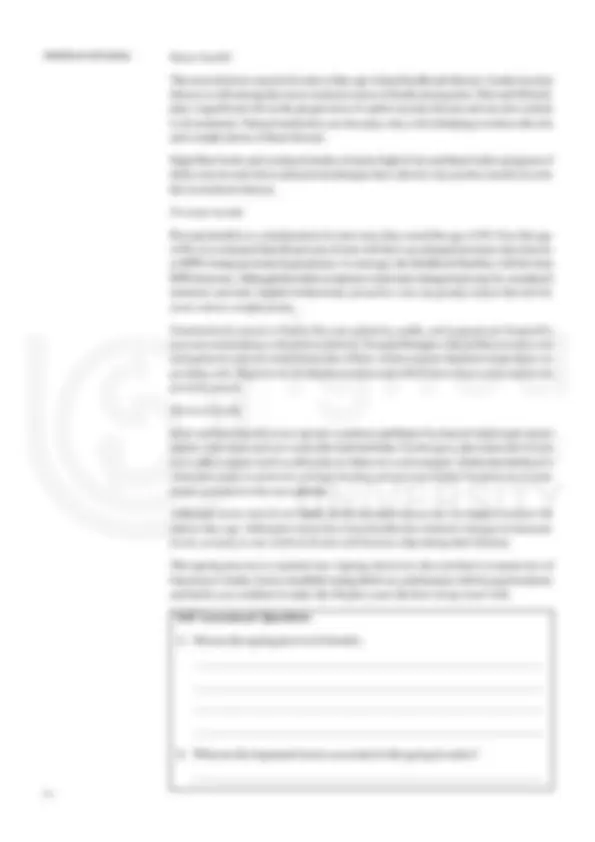
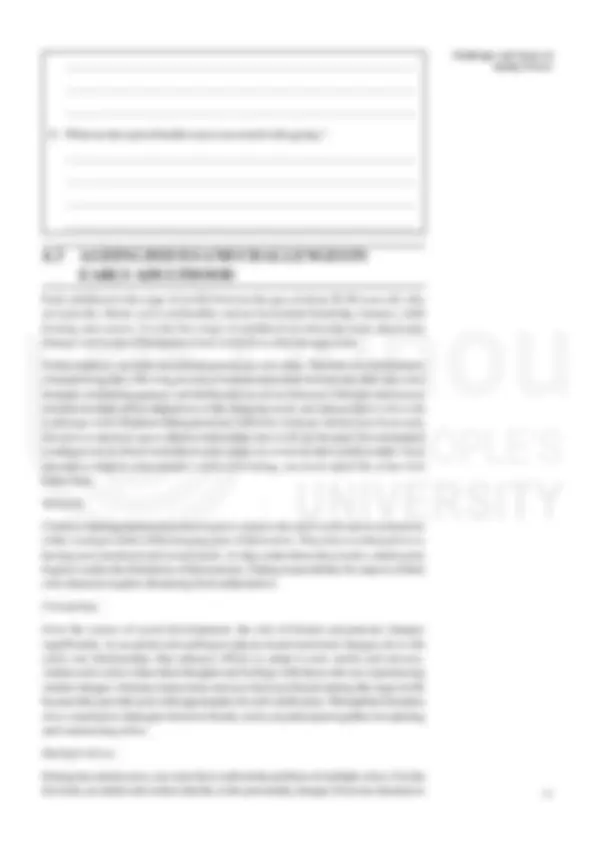
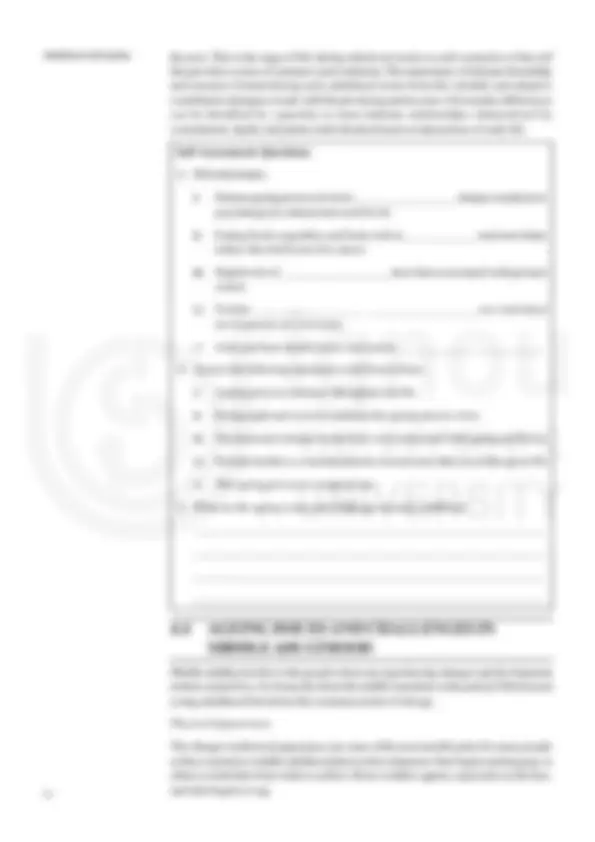
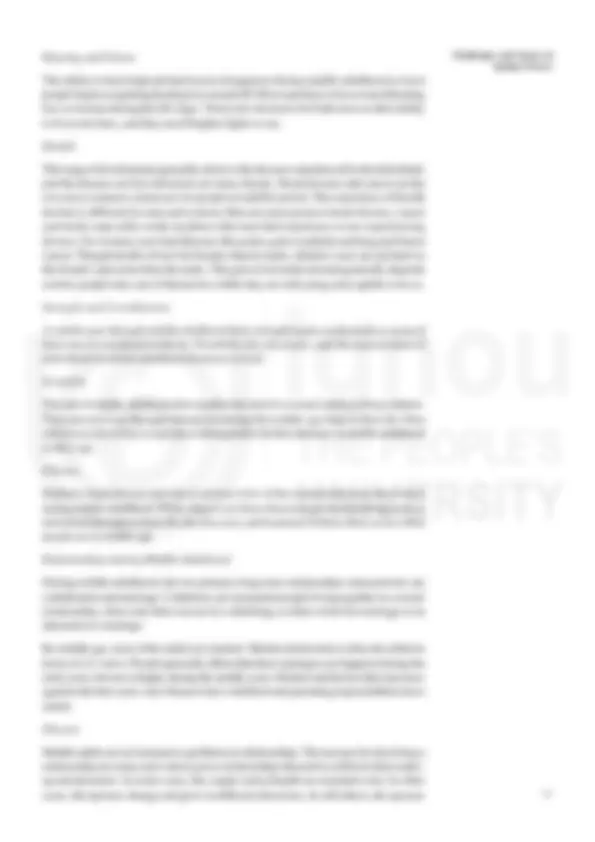
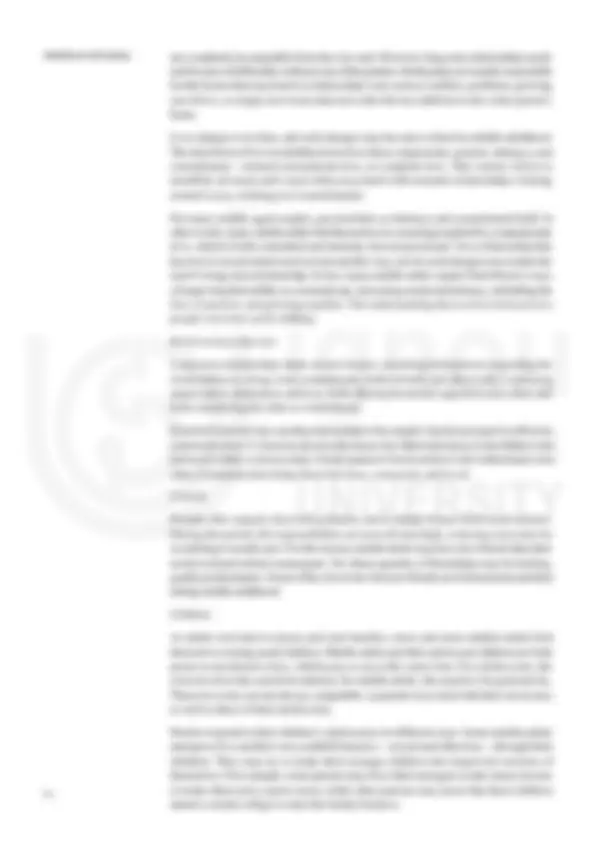
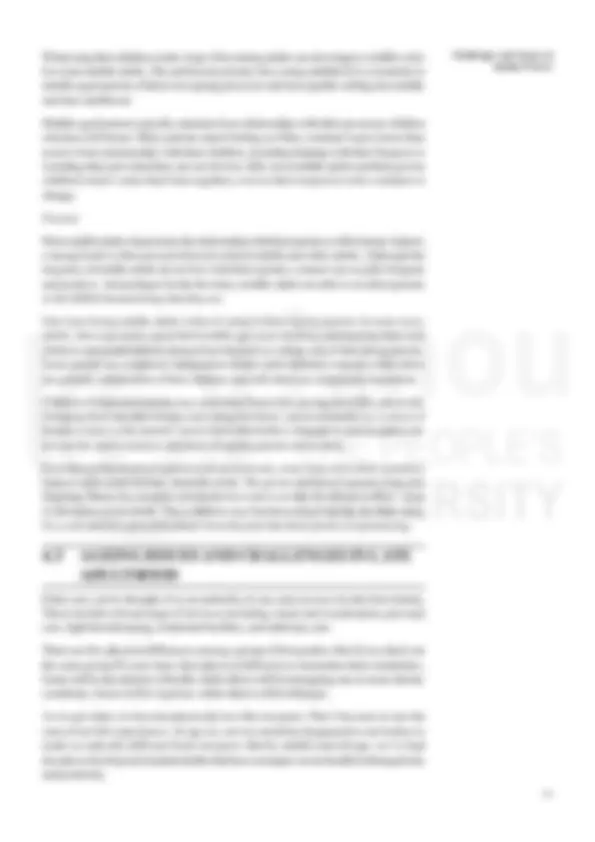
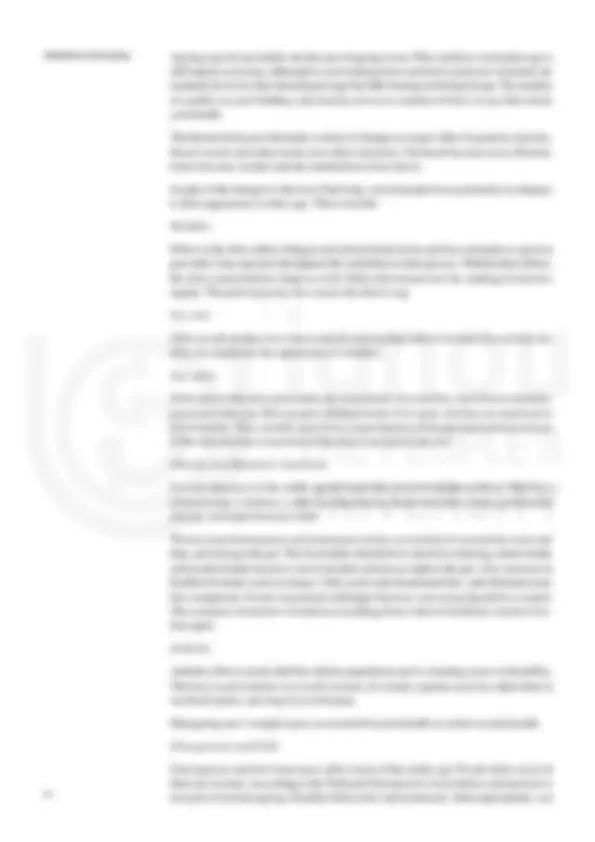
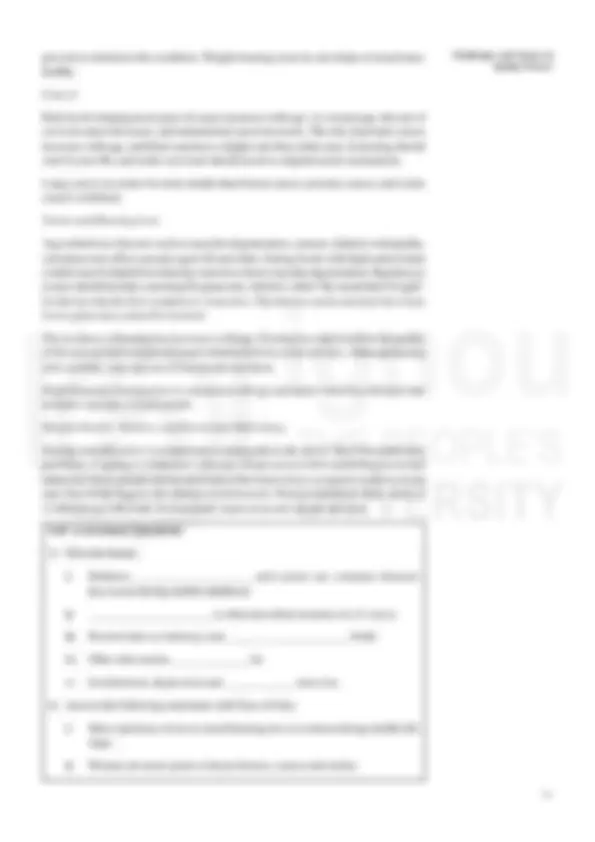
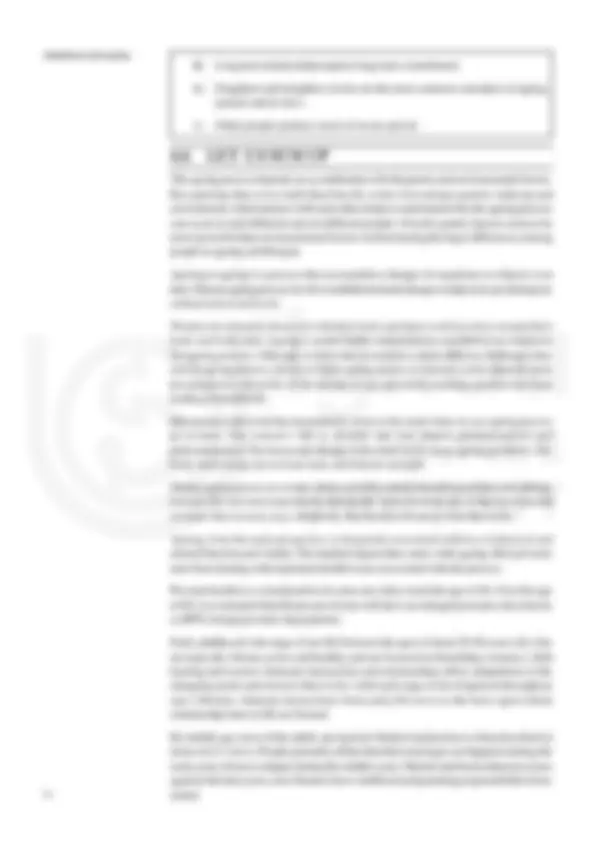
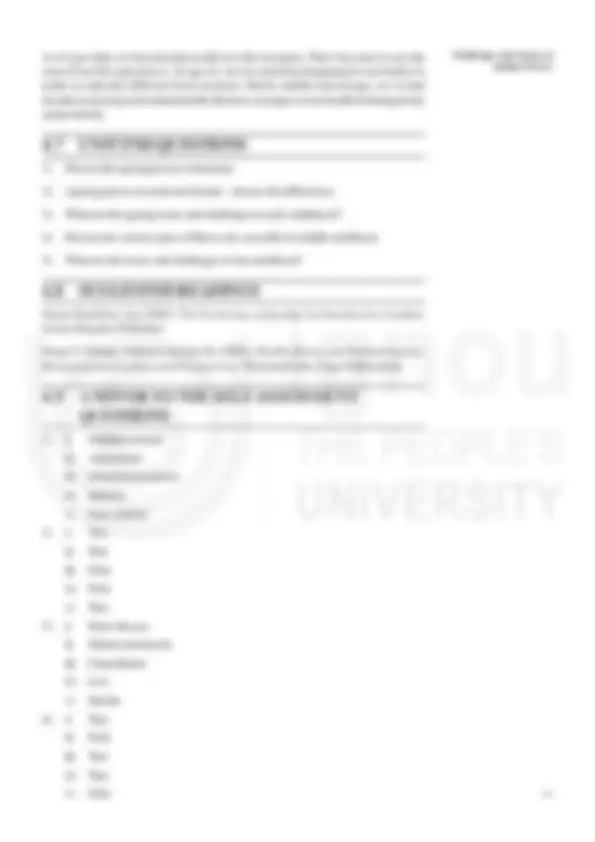


Study with the several resources on Docsity

Earn points by helping other students or get them with a premium plan


Prepare for your exams
Study with the several resources on Docsity

Earn points to download
Earn points by helping other students or get them with a premium plan
Community
Ask the community for help and clear up your study doubts
Discover the best universities in your country according to Docsity users
Free resources
Download our free guides on studying techniques, anxiety management strategies, and thesis advice from Docsity tutors
An overview of the different stages of adulthood, including early adulthood (ages 20-40), middle adulthood (ages 45-65), and old age (ages 65 and above). the physical, cognitive, and psychosocial changes that occur during each stage, as well as the objectives of studying these stages.
Typology: Study notes
1 / 59

This page cannot be seen from the preview
Don't miss anything!




















































Structure
1.0 Introduction
1.1 Objectives
1.2 Early Adulthood 1.2.1 Physical Changes
1.3 Middle Age/ Middle Adulthood
1.3.1 Physical Changes
1.4 Old Age
1.4.1 Physical Changes
1.5 Let Us Sum Up
1.6 Unit End Questions
1.7 Answer to the Self Assessment Questions
1.8 Suggested Readings
The distinction between childhood and adulthood varies considerably among cultural and social groups. The personal and social significance of the passage of years is shaped by the cultural age system. All societies divide the lifespan into recognised stages. These life stages or periods are marked by certain physical, psychological and social milestones. The life stages are commonly identified as prenatal stage (from conception until birth), infancy (from birth to the end of second year of life), early childhood (ages three to six years), middle childhood (six years until puberty), adolescence (start of puberty to adulthood), young adulthood (ages twenty to forty), middle adulthood (ages forty to sixty-five) and later adulthood or old age (sixty-five and older). This unit will help you understand the physical changes of all the three stages of adulthood.
Early adulthood is the stage of our life between the ages of about 20-40 years old, who are typically vibrant, active and healthy, and are focused on friendship, romance, child bearing and careers. It is the first stage of adulthood in which the body physically changes and is one of the hardest times in our lives after teenage years. In this stage, a person may continue to add a bit of height and weight to her teenage frame. The body continues to undergo significant hormonal changes.
In middle adulthood, an important challenge is to develop a genuine concern for the welfare of future generations and to contribute to the world through family and work.
Midlife is also viewed as a period of creativity and significant contribution to society. It is found that the best works of scientists, writers and artists are produced during the late forties and early fifties. Middle adulthood is the second stage of adulthood in which one of the most noticeable change is loss of elasticity in the skin, especially in the face. This results in lines and wrinkles that are seen as one of the first signs of ageing. 5
Adulthood and Ageing
6
Late adulthood or old age is the period of life in every individual that follows the period of his or her life after he/she turns 65 years of age. Old age consists of ages nearing or surpassing the average life span of human beings, and thus the end of the human life cycle. This period is marked by the process of growing old, resulting in part from the failure of body cells to function normally or to produce new body cells to replace those that are dead or malfunctioning.
After going through this unit, you will be able to: z discuss and understand the period of early adulthood; z understand the physical changes during early adulthood; z discuss and understand the period of middle adulthood; z understand the physical changes during middle adulthood; z discuss and understand the period of old age; and z understand the physical changes during old age.
Early adulthood is the stage of our life between the ages of about 20-40 years old, who are typically vibrant, active and healthy, and are focused on friendship, romance, child bearing and careers. It is the first stage of adulthood in which the body physically changes and is one of the hardest times in our lives after teenage years. One has to deal with so much in this time and it seems to be real time of self search as well as preparation. During this time in our life we find ourselves with a new sense of independence and for the first time in life we really feel free. However, along with that comes a lot of added personal responsibility to both ourselves and others and we really begin to learn more about ourselves as well as others through social interaction.
During the period of young adulthood one sees himself or herself as an autonomous and independent adult. In this period the individual becomes financially less dependent on the parental family. A major development task is during this period is the choice of a career. Young men and women tend to settle down in a career of their choice. In addition a young adult tries to settle down and start a family life. They are also concerned about various social issues and forming close relationships with one’s professional peers and members of community. The duties of a person demand two fold responsibilities which are towards oneself as well as the society.
The stage of young adulthood is characterised by new tasks and challenges in life such as establishing financial and emotional independence and entering into marital relationship. Unemployment and marital discord are two typical crisis conditions during early adulthood.
According to Erickson, this period is characterised by a crisis of intimacy versus isolation. The young adults must develop the ability to form deep intimate relationships with others particularly in marriage. Otherwise, they can become socially and emotionally isolated. Most young adults develop a dream of future accomplishments or a vision of what they want to achieve as a life goal. Such dreams motivate the young adults towards goal directed efforts. Occupational and marital choices and establishment of social and economic independence are some major tasks of early adulthood.
Adulthood and Ageing
8
may also notice increased sensitivity to glared-on the windshield of the car, for example, or in brightly lit stores. In their 50s people often find that it takes their eyes longer to adapt to the change in illumination when they enter a darkened theater or when they go outside on a bright sunny day. Some degrees of hearing loss is also found in many people over 50.
Middle adulthood is the second stage of adulthood in which one of the most noticeable change is loss of elasticity in the skin, especially in the face. This results in lines and wrinkles that are seen as one of the first signs of ageing. Most individuals get a little shorter through the years. Hair starts graying, skin is wrinkling, bodies are sagging and teeth are yellowing. Some adults strive to make themselves look younger by having plastic surgery, dying their hairs, wearing wigs, joining exercise programs or taking heavy vitamin doses.
Men usually gain weight in the abdominal region, while women gain weight in the hips and thighs. Strength and flexibility in both genders wane. Men during this period show greater concern towards their health, strength, power and sexual potency.
For women, menopause occurs between the ages of forty-five and fifty. Women usually experience hormonal changes during this period that result in the loss of the ability to reproduce, a process called menopause. Menopause is supposed to be accompoanied by some distressing physical and psychological symptoms in women. Both genders may experience graying of the hair or hair may be thin.
Self Assessment Questions
i) Young adults are vibrant, active and healthy.
ii) Young adults tend to get isolated due to crisis.
iii) Individual add a bit of height during middle adulthood.
iv) Attention gets focused on health and fate of children during middle age.
v) Individuals in middle age are unstable.
i) A decline in near vision is a condition known as ____________________.
ii) During middle age, there is a loss of _____________________ in skin.
iii) Women between the ages of 45 and 50, experiences ________________.
iv) Early adult’s focus on friendship, romance, _____________________ and careers.
v) Individuals due to crisis, tends to get ___________________________ during middle adulthood.
Late adulthood or old age is the period of life in every individual that follows the period of his or her life after he/she turns 65 years of age. Old age consists of ages nearing or surpassing the average life span of human beings, and thus the end of the human life cycle. People can be considered old because of certain changes in their activities or social roles. Old people have limited regenerative abilities and are more
9
prone to disease, syndromes, and sickness than other adults. For example, people can be considered as old when they become grandparents, or when they begin to do less or different work, or when they get to the age of retirement.
This period is marked by the process of growing old, resulting in part from the failure of body cells to function normally or to produce new body cells to replace those that are dead or malfunctioning. This in turn results in significant physical, psychological and cognitive changes, like cardio-vascular, digestive malfunctioning, depression, and impaired memory functioning and so on.
As an individual moves towards their old age, there are changes which occurs naturally and not due to any disease. These changes include sensory changes, digestion, circulation and sexuality. The physical changes that occur in the bodies of the individuals can be divided into two main categories – external changes and internal changes. These changes are the outward signs of ageing, and are quiet obvious to notice. They consists of changes in hair, skin, posture, etc. most people’s hair becomes distinctly gray and eventually turns white, and it may also thin out. The skin becomes less elastic, more wrinkled, dry and thin. The wrinkles are formed partly because of loss fatty tissue under the skin.
Functional age is the actual competence and performance a person displays, regardless of chronological age. People age biologically at different rates:
Young-old elderly appear physically young for their years.
Old-old elderly appear frail and show signs of decline.
Sensory Changes
Human receives and process information from the environment through hearing, vision, taste, smell and touch. With ageing, these senses are often diminished and incoming information may be distorted or difficult to understand. As a result, the older person may give up some enjoyable activities or lose contact with friends and family who are important sources of support.
Hearing
Hearing loss affects the older persons ability to talk easily with others. According to studies, about 30% of people over 60 have a hearing impairment, but about 33% of those 75 to 84, and about half of those over 85, have hearing loss. For example, older people have trouble hearing higher pitched tones. They also may not be able to make out sounds or words when there is background interference
Older persons may be frustrated or embarrassed about not being able to understand what is being said. They may have to ask people to repeat themselves, or endure shouting when a speaker tries to be heard. Older persons may hold back from conversation out of a fear of making inappropriate comments. They may tire from concentrating and straining to hear. As a result, the older person may withdraw from friends and family and outside activities.
Vision
Even though changes to the eye take place as a person ages, many older people have good-to-adequate vision. Nevertheless, beginning in the late 30s and early 40s, an individual may begin to notice some changes. She or he may have to hold the
Physical Changes (Early Adulthood, Middle Age, Old Age)
1 1
The sensation of touch connects us with others no matter what our age. Thus, touch is important in maintaining the elder’s emotional well-being. Use of touch during communication should be practiced to show that you are there for support and that you care.
Changes in Bones and Muscles
Ageing adults, especially the very old, are vulnerable to broken bones. In addition, joints stiffen and connecting ligaments between bones lose their elasticity. Hand and foot pain may result.
Although there is no known way to prevent sometimes painful changes in ageing muscles, bones, and ligaments, regular exercise helps to assure continuing mobility in old age. Most physicians feel that walking, along with adequate rest and a nutritious diet, are tremendously valuable for maintaining mobility and fitness in the later years.
It is very important to prevent falls. Due to changes in bone mass and strength, falls often result in injury, hospitalisation, and continued declines in health.
Teeth and Mouth
Older adults are more likely to lose teeth to gum disease than to problems with the teeth themselves. However, with proper personal care, regular checkups, and improved dentistry methods, older people are more able to retain their natural teeth throughout their lives. Older people who do lose their teeth may now expect and demand comfortable, well-fitting, and durable dentures.
Digestion
The digestive system is very sensitive to emotions. An older person may experience an upset stomach or lack of appetite when lonely, depressed, or worried. Regular contact with friends and relatives, through visits and telephone calls, can help prevent these problems.
It is fairly common for older people to have less frequent bowel movements and to suffer from constipation. This is due to changes in tissue and muscles and reduced thirst. Regular exercise, such as a daily walk, can prevent constipation. A well- balanced diet that includes adequate fiber and fluid intake also encourages normal bowel function and minimises the need for laxatives. In contrast, self-prescribed laxatives are an expensive substitute for foods that naturally keep the gastrointestinal system running smoothly, such as bran cereals, fruits, and vegetables. Overuse of laxatives can interfere with the availability of nutrients for healthy body functioning.
Adequate fluid intake is essential for maintaining proper body temperature and functioning of the digestive system. However, some older people make the mistake of limiting their fluid intake in order to avoid frequent urination. Dehydration is a serious problem for the elderly. This is due to their decreased sense of thirst and reduced capacity to conserve water. In addition, laxative abuse, diuretic therapies, infections, immobility, or excessive use of alcohol or caffeine tend to promote dehydration.
Circulation
The older heart slows down and is less able to pump blood through the body than the younger heart. This results in older people having less energy and stamina for physical work. Decreased circulation also contributes to cold sensitivity, particularly in the hands and feet. Because oxygen necessary for proper physical and cognitive
Physical Changes (Early Adulthood, Middle Age, Old Age)
Adulthood and Ageing
1 2
functioning is carried through the blood, the elder with poor circulation may experience forgetfulness and other symptoms of poor cognition.
Blood vessels, which play an important role in the circulation of blood throughout the body, lose elasticity as we age. This causes blood to tend to “pool” in the feet and legs. This means that swelling (edema) may occur in the extremities. Consequently, the heart, which undergoes muscle changes as we age, must pump harder in order to carry the blood to all parts of the body.
Changes in circulation make the older person more susceptible to the development of “little strokes” (TIAs) than when younger. Symptoms of such episodes include headache, vision disturbances, loss of balance, confusion, and dizziness when standing quickly from a sitting or reclining position. Because “little strokes” can be harbingers of a larger stroke, consult with the older person’s primary health care provider, should these occur.
Many older people are on medications that impact circulation. Be familiar with these medications, and their side effects. This may prevent complications, which may arise from their use.
Pressure ulcers, a skin problem found in people with limited mobility, are due to impaired circulation. When an older person is unable to move about, tissue may die due to lack of an adequate blood supply to the skin. Areas particularly susceptible to these ulcers are those over bony prominences such as hips, shoulders, elbows, knees, ankles, and the heels of the feet.
Cardiovascular and Respiratory Systems
They are affected by ageing as the heart muscle becomes more rigid and some cells enlarge, thickening the left ventricle. Arteries stiffen and accumulate plaque. So the heart pumps with less force, and blood flow slows. So during activity, sufficient oxygen may not be delivered to critical tissues. Lung tissue also loses elasticity and capacity is reduced by half. The blood absorbs less oxygen and expels less carbon dioxide. People feel more out of breath when exercising. This is more of a problem for people who have smoked, had a high-fat diet, or been exposed to pollutants. Exercise facilitates respiratory function.
Immune system declines as T cells become less effective.
Auto-immune response is a problem when the immune system turns against normal body tissues. This puts elders at risk of infectious diseases, CVD, cancers, rheumatoid arthritis, or diabetes. The more impaired the immune system is, the more at risk the person is to a variety of agents.
Sleep is essential for healthy functioning all one’s life, but as we age, sleep is harder to come by, as elders sleep less, more lightly, and have more trouble going to sleep. Men seem to have more sleep problems than women, due to the enlargement of the prostate gland and the need to urinate more often at night.
Sleep apnea is a condition where breathing ceases for 10 sec. or more, causing the person to awaken with a start to breathe again. This afflicts more men than women, but overweight people have problems with this condition, as more weight is pressing on the lungs, requiring more effort to keep breathing. Legs also move rapidly during the night- “restless legs” and this can disrupt sleep, too. Unfortunately poor sleep can afflict daytime energy, resulting in a cycle of downward energy, even depression.
Adulthood and Ageing
1 4
for men than women in late life. Driving is especially impaired as vision is impaired. They also have a slower reaction time, and don’t always read and interpret road signs effectively. They are also at risk on foot at intersections when they can’t determine when to walk.
Falls – 30% of those over 65, and 40% of those over 80 have had a fall within the past year. Serious injury results about 10% of the time- most commonly a hip fracture. This type of break increases 20% from 65 to 85. It associates with a 12
Prevention may entail corrective eyewear, improved safety in the home or car, and other family members taking on some of the responsibility for the elder’s transportation.
Self Assessment Questions
i) Old age starts from the age of 50 years. ( ) ii) Old people have limited regenerative abilities and are more prone to disease, syndromes, and sickness than other adults. ( ) iii) Young-old elderly appear frail and show signs of decline. ( )
iv) With ageing, peripheral vision is reduced. ( ) v) The older heart slows down and is less able to pump blood through the body than the younger heart. ( )
i) Degeneration of eye muscles and ________________ of the lens are associated with ageing.
ii) The skin serves a ________________ function by buffering us from the environment.
iii) Regular exercise, such as a daily walk, can prevent ______________. iv) Immune system declines as _________________ become less effective.
v) ________________ is a condition of inflamed, painful, stiff or swollen joints and muscles.
Early adulthood is the stage of our life between the ages of about 20-40 years old, who are typically vibrant, active and healthy, and are focused on friendship, romance, child bearing and careers. It is the first stage of adulthood in which the body physically changes and is one of the hardest times in our lives after teenage years. During the period of young adulthood one sees himself or herself as an autonomous and independent adult. In this period the individual becomes financially less dependent on the parental family. A major development task is during this period is the choice of a career. The stage of young adulthood is characterised by new tasks and challenges in life such as establishing financial and emotional independence and entering into marital relationship. Unemployment and marital discord are two typical crisis conditions during early adulthood.
1 5
Females reach their adult heights by age 18, and, except for some males who continue to grow in their early 20s, most have reached their adult heights by the age of 21. However, muscles continue to gain mass – especially among males, and both genders continue to add body fat. Average weight gain for both men and women is about 15 pounds.
In middle adulthood, an important challenge is to develop a genuine concern for the welfare of future generations and to contribute to the world through family and work. This period is aged between 40-60 years of life. From the period of twenties and thirties, the individual arrives at middle age in the forties and fifties. Middle age is characterised by competence, maturity, responsibility and stability. This is the time when one wants to enjoy the success of job, satisfaction derived from the family and social life. People look forward to the success of their children.
Middle adulthood is the second stage of adulthood in which one of the most noticeable change is loss of elasticity in the skin, especially in the face. This results in lines and wrinkles that are seen as one of the first signs of ageing. Most individuals get a little shorter through the years. Hair starts graying, skin is wrinkling, bodies are sagging and teeth are yellowing. Some adults strive to make themselves look younger by having plastic surgery, dying their hairs, wearing wigs, joining exercise programs or taking heavy vitamin doses.
Late adulthood or old age is the period of life in every individual that follows the period of his or her life after he/she turns 65 years of age. Old age consists of ages nearing or surpassing the average life span of human beings, and thus the end of the human life cycle. People can be considered old because of certain changes in their activities or social roles. Old people have limited regenerative abilities and are more prone to disease, syndromes, and sickness than other adults.
Functional age is the actual competence and performance a person displays, regardless of chronological age. The ageing body does change. Some systems slow down, while others lose their “fine tuning”. Slight gradual change is common, and most of these are not problems to the person who experiences them. Serious and dramatic change may indicate serious health problems.
As an individual moves towards their old age, there are changes which occurs naturally and not due to any disease. These changes include sensory changes, digestion, circulation and sexuality. The physical changes that occur in the bodies of the individuals can be divided into two main categories – external changes and internal changes. These changes are the outward signs of ageing, and are quiet obvious to notice. They consists of changes in hair, skin, posture, etc. most people’s hair becomes distinctly gray and eventually turns white, and it may also thin out. The skin becomes less elastic, more wrinkled, dry and thin. The wrinkles are formed partly because of loss fatty tissue under the skin.
What are the physical changes that take place in early adulthood?
What are the developmental tasks during this period?
What are the physical changes that take place in middle adulthood?
What are the developmental tasks of this period?
What are the physical changes that take place during old age?
What are the developmental tasks of this period?
Physical Changes (Early Adulthood, Middle Age, Old Age)
1 7
Structure
2.0 Introduction
2.1 Objectives
2.2 Early Adulthood 2.2.1 Cognitive Changes
2.3 Middle Adulthood
2.3.1 Cognitive Changes
2.4 Old Age
2.4.1 Cognitive Changes
2.5 Let Us Sum Up
2.6 Unit End Questions
2.7 Suggested Readings
2.8 Answers to the Self Assessment Questions
Young adulthood is a time when most of us finish school, find a career we enjoy, and create a family of our own. The cognitive stages during the early adulthood can be discussed as a period of realistic and pragmatic thinking; reflective and relativistic thinking. According to Piaget, he thought that young adults were quantitatively advanced in their thinking (they have more knowledge), however, they are qualitatively similar. He also believed that adults increase their knowledge in a specific area.
In this unit we will be dealing with all the three stages of adulthood and examine the physical, cognitive and other changes that come about. Particularly the focus will be on cognitive development.
After going through this unit, you will be able to:
z define and describe the period of early adulthood;
z describe the cognitive changes during early adulthood;
z explain the characteristics of middle adulthood;
z delineate the cognitive changes during middle adulthood;
z define and describe the period of old age; and
z analyse the cognitive changes during old age.
Young adulthood is a time when most of us finish school, find a career we enjoy, and create a family of our own. Physically, it is a time where we are our healthiest and will reach our peak performance. Cognitively, it is a time to grow up and make life decisions.
Adulthood and Ageing
1 8
Socioemotionally, it is a time to take on roles of independence, lifestyles, marriage, and family.
According to Erik Erikson’s eight stages of development, this is a time of intimacy vs. isolation. One either gets involved in an intimate relationship or isolates oneself. According to the literature, many areas of development are paramount during early adulthood.
The cognitive stages during the early adulthood can be discussed as a period of realistic and pragmatic thinking; reflective and relativistic thinking. According to Piaget, he thought that young adults were quantitatively advanced in their thinking (they have more knowledge), however, they are qualitatively similar. He also believed that adults increase their knowledge in a specific area.
Between the ages of 35-60, we find vast changes in many areas of our lives. The most obvious changes related to our lifestyle include: physical development and health, career and finances, marraige, and leisure activities. For many, midlife is a time when they start to think about “how much time they have left”. Individuals begin to reexamine their lives, their relationships, their work, and even to question the meaning of it all. This process has been referred to as a mid-life crisis. Clearly, middle adulthood is a time change and development.
Middle adulthood is the period in which an individual changes in their cognitive functioning as concerned to their intelligence: crystallized and fluid; information processing and memory; expertise; career, work and leisure; religion, health and coping; and meaning in life.
While the adult years are generally a time of vitality and good health, their are health concerns. The main health problems of middle adulthood are cardiovascular disease, cancer, and menopause. Another major problem that effects health and behaviour is stress. Overall this is a time of major change and development physically and mentally.
During the middle adult years there is a noticeable change in how adults view their careers. By this time most individuals have settled into their careers and between the ages of 40-45 have ceased to advance up the career ladder. In general, job satisfaction and commitment tend to be high and continue to increase into our sixties.
It is also at this time that adults adjust their idealistic hopes to realistic possibilities. This adjustment to attainable goals is dependent on how much time is left before retirement, with retirement planning being a major area of financial concern. These reassesments may lead to stress and sadness over unaccomplished goals, which for a small few may lead to a midlife career change.
Crystallized intelligence improves through middle age and on. The ability to remember and use information acquired over a lifetime is increased, and also depends on education and culture of the individual. An individual is able to use stored information’s and process automatically in their daily lives.
Many psychologists believe that fluid intelligence was primarily genetic and that crystallized intelligence was primarily learned. This nature-nurture distinction is probably invalid, in part because the acquisition of crystallized intelligence is affected by the quality of fluid intelligence.
Another financial adjustment that tends to take place for many midadults is the planning for college and setting aside the necessary funds for their children. In response to these growing financial needs and greater free time, due to their children getting older, many women enter or reenter the workforce. In short, this tends to be a time of career and financial readjustment and planning for both men and women.
Adulthood and Ageing
2 0
focus their energy on finding their niche in the work place and society. During young adulthood, logical skills don’t decline because cognitive abilities are strong.
Reflective and Relativistic Thinking
William Perry said that adolescents often engage in dualistic, absolute thinking, whereas adults are more likely to engage in reflective, relativistic thinking. The term dualistic thinking is used to describe an adolescents view of the world. Everything is seen in the polar terms or opposites. Examples for this are right/wrong or good/bad.
As youth mature, dualistic thinking is replaced by multiple thinking. They gradually become aware of the diversity of opinion in other people and realise that authority may not have all the answers. Young adults begin to create their own style of thinking, and believe that others are entitled to the opinion they hold and that one opinion is good as anyone’s else’s. This leads to the next form of thinking, relative subordinate thinking. Here, personal opinions begin to be challenged by others, and a logical evaluation of knowledge is actively pursued. This leads to the final form of thinking, which is full relativism. In this stage of thinking, young adults completely understand that truth is relative, and knowledge is constructed and not given, contextual and not absolute. Post formal thought is qualitatively different than Piaget’s formal operational thought. It involves understanding that the correct answer to a problem requires reflective thinking, may vary from one situation to another, and that the search for truth is often an ongoing, never-ending process. Along with this is the belief that solutions to problems need to be realistic and that emotion and subjective factors can influence thinking.
Middle age is the period of age beyond young adulthood but before the onset of old age. Various attempts have been made to define this age, which is around the third quarter of the average life span of human beings. In middle adulthood, an important challenge is to develop a genuine concern for the welfare of future generations and to contribute to the world through family and work. This period is aged between 40-60 years of life.
From the period of twenties and thirties, the individual arrives at middle age in the forties and fifties. Middle age is characterised by competence, maturity, responsibility and stability. This is the time when one wants to enjoy the success of job, satisfaction derived from the family and social life. People look forward to the success of their children. Attention gets more focused on health, the fate of children, ageing parents, the use of leisure time and plans of old age. Middle aged adults often show visible signs of ageing such as loss of skin elasticity and graying of hair. Physical fitness usually wanes, with a 5-10kg accumulation of body fat, reduction in aerobic performance and a decrease in maximal heart rate. Strength and flexibility also decrease throughout middle age. However, people age at different rates and there can be significant differences between individuals of the same age. Midlife is also viewed as a period of creativity and significant contribution to society. It is found that the best works of scientists, writers and artists are produced during the late forties and early fifties. The changes that occur from adolescence to young adulthood may be stressful at times, but between the ages of 19 and 30 we are at our prime physically, and our cognitive skills are becoming finalised. Sure, sometimes it seems like we’re dealing with a million things all at once and that one of any number of things could change the rest of our lives,
2 1
but that’s the best part about it. Young adulthood is when (most of us) decide exactly what it is that we want to do with the rest of our lives whether it’s raise a family, start a career, or both.
Middle adulthood is the period in which an individual changes in their cognitive functioning as concerned to their intelligence: crystallized and fluid; information processing and memory; expertise; career, work and leisure; religion, health and coping; and meaning in life.
Intelligence
Cognitive development is multidirectional. It gains in some area and losses in others. Cross sectional measures of intelligence show decreases with age. There may be cohort effect of better or more schooling. Longitudinal measures show increase, at least until the age of 50s. It may be inflated due to practice effects and attrition. Cognitive abilities are more likely to increase than decrease, with exception of arithmetic skills, which begin to shift slightly downwards by age 40.
Fluid intelligence refers to our ability to see relationships, use abstract reasoning, and analyse information. Crystallized intelligence refers to our ability to use knowledge, experience, vocabulary, and verbal memory (Horn & Hofer, 1992). Fluid intelligence declines with age, but crystallized intelligence continues to grow as we learn more during middle age.
z Fluid Intelligence
Fluid intelligence is the flexible reasoning and is made up of the basic mental abilities such as inductive reasoning, abstract thinking and speed of thinking required for understanding any subject. It is fast and abstract reasoning, in adults, there is a decline with age. It includes nonverbal abilities and nonverbal puzzle solving, novel logic problems; allows best works at age 20s and 30s by mathematicians, scientists and poets.
Fluid intelligence peaks during the early adulthood and then declines ability to apply mental powers to new problems, perceiving relationships, forming concepts and drawing inferences. It declines probably due to changes in brain. These differences might be due to cohort effects related to educational differences rather than to age.
z Crystallized Intelligence
Crystallized intelligence is the verbal reasoning that holds across the lifespan which reflects accumulated knowledge and vocabulary. It allows best works at age of 40s, 50s, and older by historians, philosophers, prose writers. It refers to the accumulation of facts, information and knowledge that comes with education and experience within a particular culture.
Crystallized intelligence improves through middle age and on. The ability to remember and use information acquired over a lifetime is increased, and also depends on education and culture of the individual. An individual is able to use stored information’s and process automatically in their daily lives.
Many psychologists believe that fluid intelligence was primarily genetic and that crystallized intelligence was primarily learned. This nature-nurture distinction is probably invalid, in part because the acquisition of crystallized intelligence is affected by the quality of fluid intelligence.
Cognitive Changes (Early Adulthood, Middle Age, Old Age)
2 3
According to Victor Frankl, the examining of the finiteness of our existence leads to exploration of meaning in life. Many middle-aged individuals increasingly examine life’s meaning.
Self Assessment Questions
iv) As youth mature, dualistic thinking is replaced by multiple thinking. ( )
v) Crystallized intelligence is in peak during middle adulthood. ( )
i) Creativity involves the capacity to be ____________ and innovative when dealing with new situations.
ii) ________________________ refers to our ability to see relationships, use abstract reasoning and analyse information. iii) _____________________ means looking at all aspects of situations before making conclusions. iv) Cognitive development is ________________________.
v) Religion and _____________________ is an important dimension of life during middle adulthood.
Late adulthood (old age) is generally considered to begin at about age 65. Erik Erikson suggests that at this time it is important to find meaning and satisfaction in life rather than to become bitter and disillusioned, that is, to resolve the conflict of integrity vs. despair. Despite the problems associated with longevity, studies of people in their 70s have shown that growing old is not necessarily synonymous with substantial mental or physical deterioration. Many older people are happy and engaged in a variety of activities. Gerontology , an interdisciplinary field that studies the process of ageing and the ageing population, involves psychology, biology, sociology, and other fields.
Late Adulthood is the period in an individual’s life beginning at ages sixty or seventy and ending at death. This life period, like any other, is one of continuing change and adjustment both in the physical and the psychosocial realms.
Theories of successful ageing include the following:
The disengagement theory states that as people age, their withdrawal from society is normal and desirable as it relieves them of responsibilities and roles that have become difficult. This process also opens up opportunities for younger people; society benefits as more-energetic young people fill the vacated positions.
The activity theory contends that activity is necessary to maintain a “life of quality,”
Cognitive Changes (Early Adulthood, Middle Age, Old Age)
Adulthood and Ageing
2 4
that is, that one must “use it or lose it” no matter what one’s age and that people who remain active in all respects—physically, mentally, and socially—adjust better to the ageing process. Proponents of this theory believe that activities of earlier years should be maintained as long as possible.
Ageism may be defined as the prejudice or discrimination that occurs on the basis of age. Although it can be used against people of all ages, older people are most frequently its target and it may often result in forced retirement. Stereotyping of the elderly is also an aspect of ageism, as seen in such a statement as “He drives like a little old lady.”
Cognitive development is a general loss cognitively as people move closer to the end of life. The study of cognitive changes in the older population is complex. Response speeds (neural and motor) have been reported to decline; some researchers believe that age- related decrease in working memory is the crucial factor underlying poorer performance by the elderly on cognitive tasks.
Selective optimisation with compensation is one means of making best use of their cognitive skills. They narrow their goals, select personally valued activities so as to optimise or maximise returns from their energy. They find means to compensate for losses.
Factors related to Cognitive change – mentally active people are likely to maintain their cognitive abilities into advanced old age. Retirement can bring about changes in cognitive abilities depending on how those years are used. Terminal decline is a steady, marked decrease in cognitive functioning prior to death.
Memory
The older adults are taking in information more slowly, and they use strategies less, can’t inhibit irrelevant information and retrieve important information from long-term memory. So memory failure increases. Slower processing speed means there will be less retained from current activities. They also forget context, which helps us recall information. Recognition memory does not decline as much as free recall. z Deliberate vs. automatic memory Implicit memory is memory without conscious awareness. This memory is more intact than deliberate memory, trying to recall information. z Associative memory Associative memory deficit is a problem creating and retrieving links between pieces of information. This is more common for elders. z Remote memory is very long-term recall. It is not any clearer than recent recall for seniors, even though the myth is that seniors remember the past better than recent events. z Autobiographical memory is memory for your own personally experienced events. Seniors best recall their adolescent and early adulthood experiences better than later life experiences. There was a lot of novelty in those times, as well as life choices being made- spouses, jobs, educational choices. These experiences were more emotionally charged, so they are remembered better. They become part of a person’s life story, and are remembered often. z Prospective memory is remembering to do planned activities in the future. There is more forgetfulness and absentmindedness as people age. They tend to do better on event-based memory tasks than time-based tasks.